Sony Group PCG4A1L Laptop with WLAN User Manual Fuji3
Sony Corporation Laptop with WLAN Fuji3
Contents
- 1. Manual
- 2. Installers guide
Manual
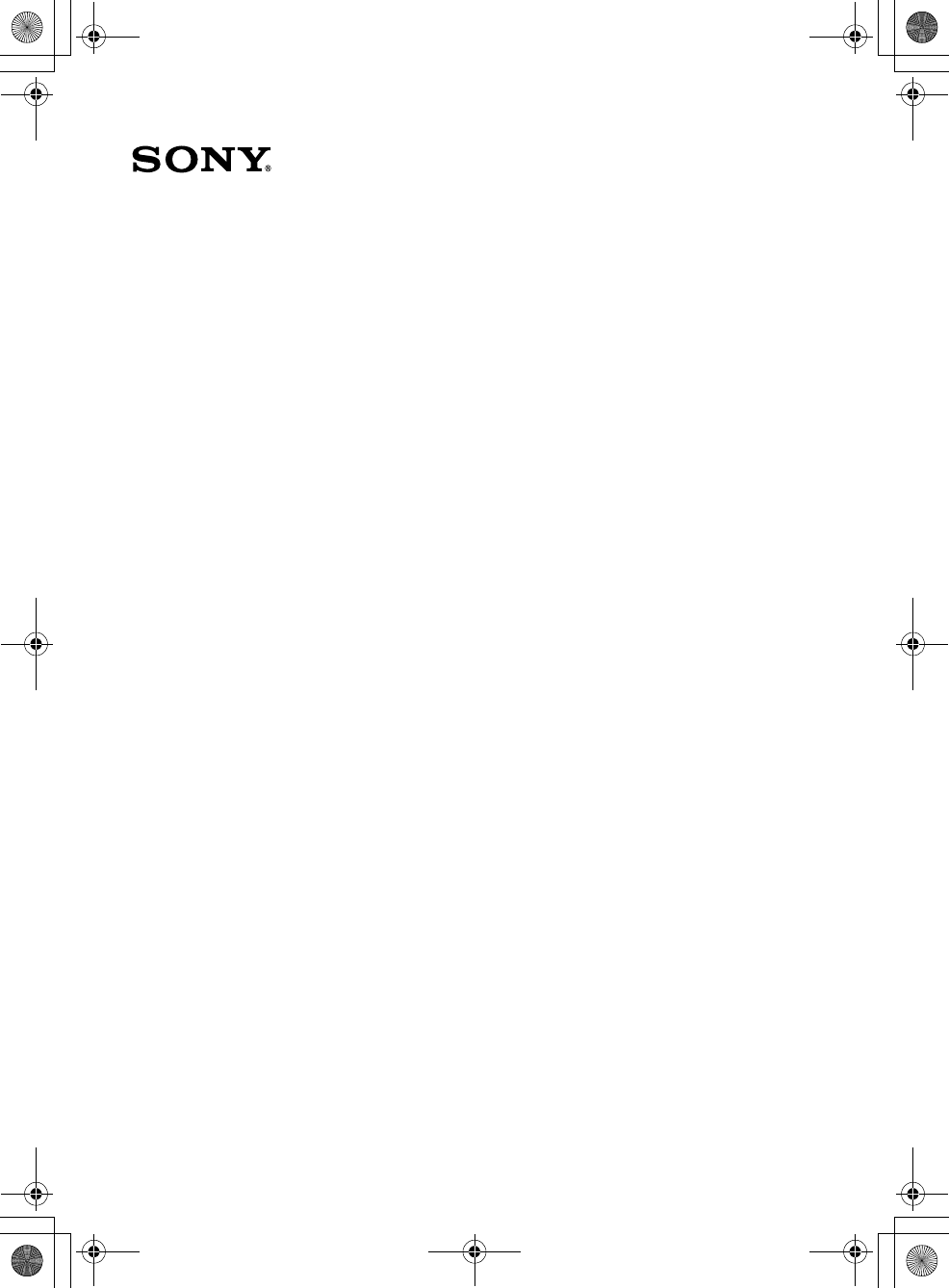
VAIO® Computer
Quick Start
PCG-TR3 Series
Fuji3.book Page 1 Monday, December 15, 2003 6:34 PM
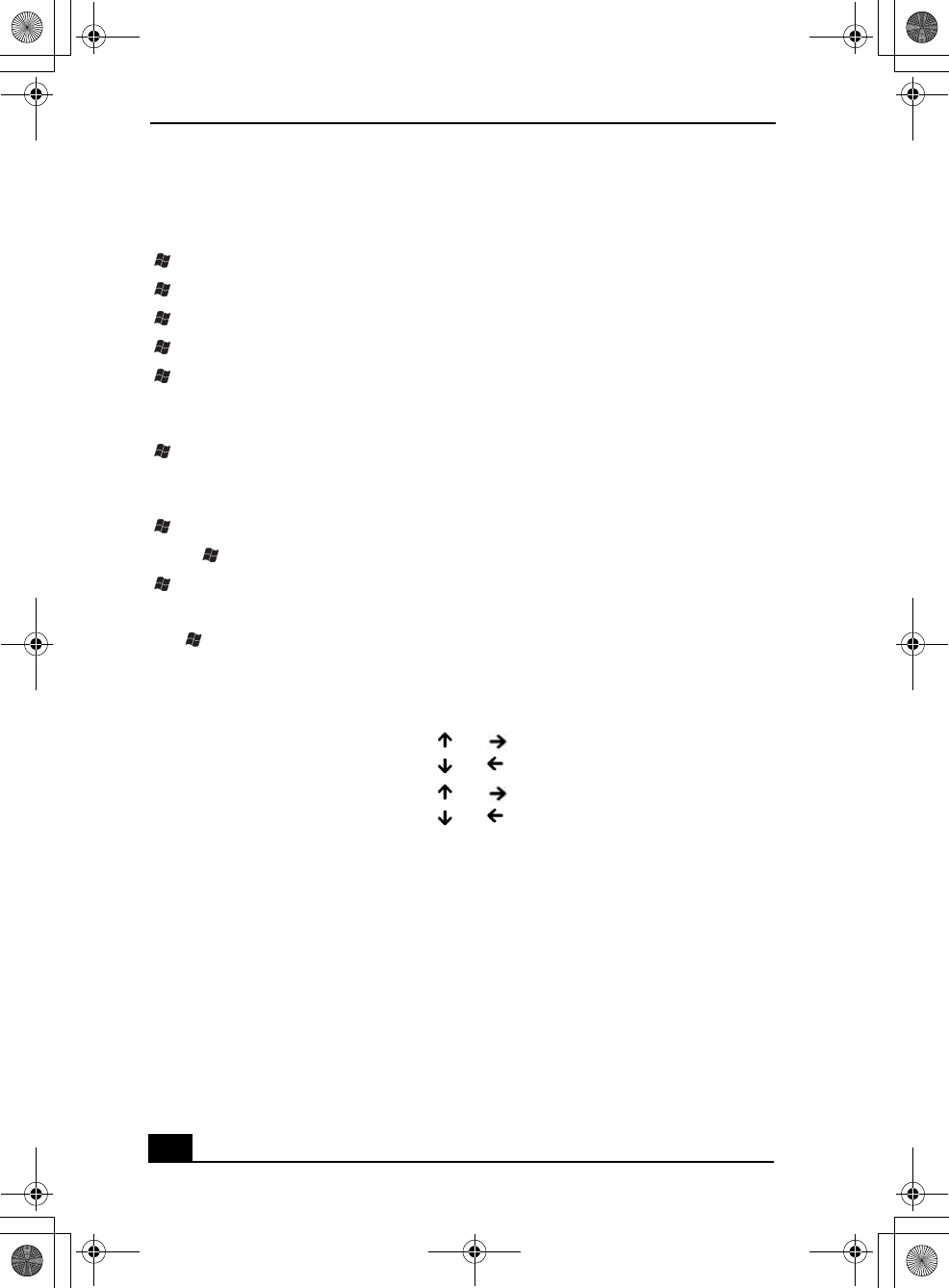
VAIO® Computer Quick Start
2
Shortcut Menu
+F1 Displays the VAIO Help and Support Center window.
+Tab Switches the selected button on the taskbar.
+D Displays the desktop.
+E Displays the My Computer window.
+F Displays the Search Results window, where you can find a
file or folder. This is the equivalent of selecting Search from
the Start menu.
+Ctrl+F Displays the Search Results - Computers window, where
you can locate other computers. This is the equivalent of
selecting Search, and then Computer from the Start menu.
+M Minimizes all displayed windows.
Shift+ +M Returns all minimized windows to their previous size.
+R Displays the Run window. This is the equivalent of selecting
Run from the Start menu.
Fn+ +Insert Displays the System Properties window. This is the
equivalent of selecting Control Panel, and then System from
the Start menu.
Fn+F3 Toggles the built-in speakers off and on.
Fn+F4 Together with the or keys, it increases volume.
Together with the or keys, it decreases volume.
Fn+F5 Together with the or keys, it increases brightness.
Together with the or keys, it decreases brightness.
Fn+F7 Toggles the display between the computer screen (LCD), a
connected external display, and both the LCD and an
external display.
Fn+F12 Puts the system into Hibernate mode, a power management
state. To return the system to normal operating mode, press
the power button.
Fn+Esc Puts the system into Standby mode, a power management
state. To return the system to the active state, press any key
or the power button.
Fuji3.book Page 2 Monday, December 15, 2003 6:34 PM
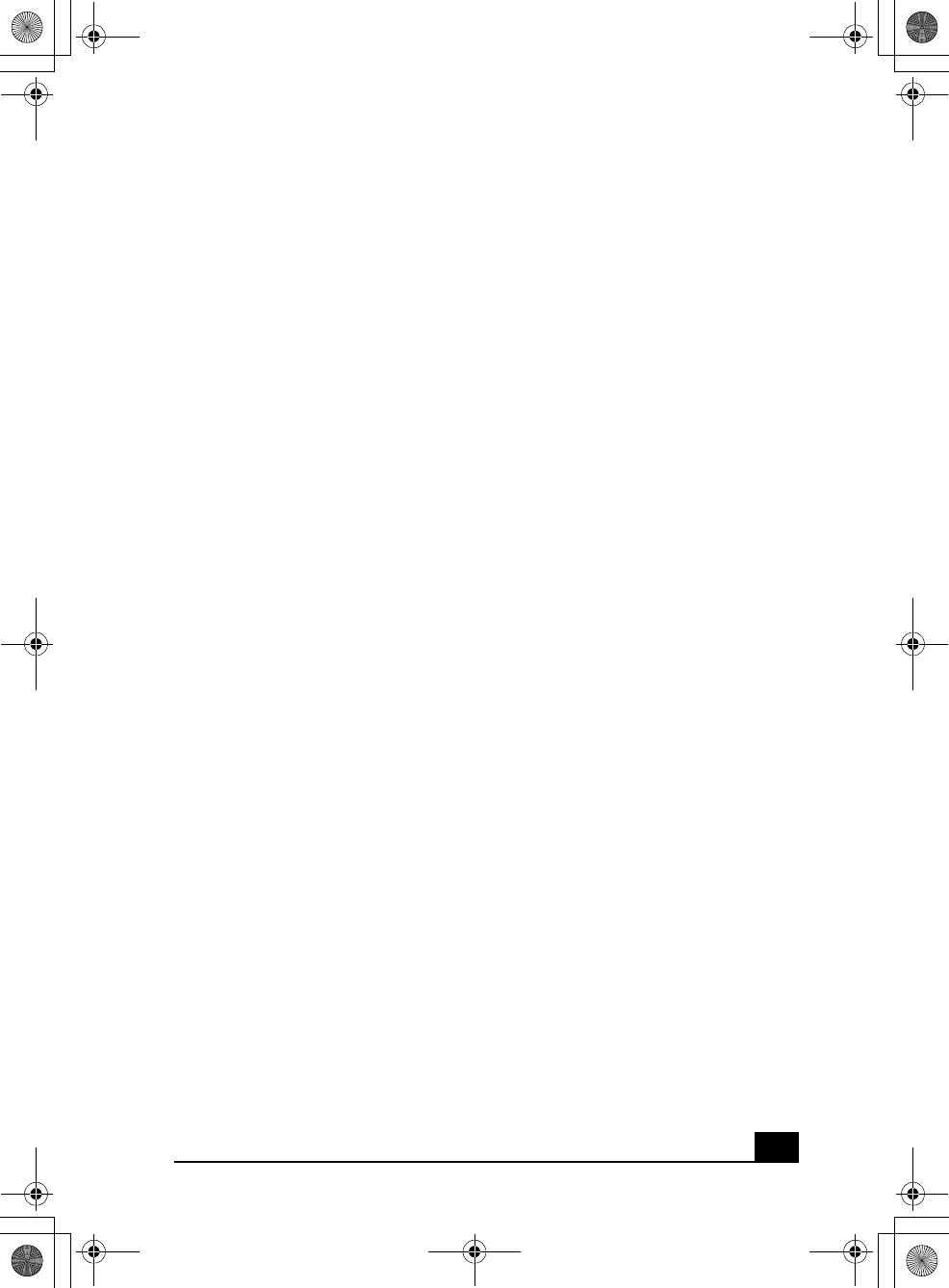
3
Contents
Notice to Users ............................................5
Setting Up ..................................................15
Unpacking Your Computer .......................................15
Locating Controls and Ports......................................17
Getting Started ..........................................23
Turning On Your Computer......................................23
Using the Touch Pad .................................................26
Registering Your Computer ......................................27
Locating Your VAIO Computer User Guide ............28
Setting Up A Dial-Up Connection ............................30
Turning Off Your Computer .....................................31
VAIO Recovery Wizard Utility...................33
Troubleshooting ........................................35
Support Options.........................................................38
Fuji3.book Page 3 Monday, December 15, 2003 6:34 PM

VAIO® Computer Quick Start
4
Fuji3.book Page 4 Monday, December 15, 2003 6:34 PM

5
Notice to Users
© 2004 Sony Electronics Inc. All rights
reserved. This manual and the software
described herein, in whole or in part, may not
be reproduced, translated, or reduced to any
machine-readable form without prior written
approval.
SONY ELECTRONICS INC. PROVIDES NO
WARRANTY WITH REGARD TO THIS
MANUAL, THE SOFTWARE, OR OTHER
INFORMATION CONTAINED HEREIN
AND HEREBY EXPRESSLY DISCLAIMS
ANY IMPLIED WARRANTIES OF
MERCHANTABILITY OR FITNESS FOR
ANY PARTICULAR PURPOSE WITH
REGARD TO THIS MANUAL, THE
SOFTWARE, OR SUCH OTHER
INFORMATION. IN NO EVENT SHALL
SONY ELECTRONICS INC. BE LIABLE
FOR ANY INCIDENTAL,
CONSEQUENTIAL, OR SPECIAL
DAMAGES, WHETHER BASED ON TORT,
CONTRACT, OR OTHERWISE, ARISING
OUT OF OR IN CONNECTION WITH THIS
MANUAL, THE SOFTWARE, OR OTHER
INFORMATION CONTAINED HEREIN OR
THE USE THEREOF.
Sony Electronics Inc. reserves the right to make
any modification to this manual or the
information contained herein at any time
without notice. The software described herein is
governed by the terms of a separate user license
agreement.
This product contains software owned by Sony
and licensed by third parties. Use of such
software is subject to the terms and conditions
of license agreements enclosed with this
product. Some of the software may not be
transported or used outside the United States.
Software specifications are subject to change
without notice and may not necessarily be
identical to current retail versions.
Updates and additions to software may require
an additional charge. Subscriptions to online
service providers may require a fee and credit
card information. Financial services may
require prior arrangements with participating
financial institutions.
The International ENERGY STAR® Office
Equipment Program is an international program
that promotes energy saving through the use of
computers and other office equipment. The
program backs the development and
dissemination of products with functions that
effectively reduce energy consumption. It is an
open system in which business proprietors can
participate voluntarily. The targeted products
are office equipment such as computers,
displays, printers, facsimiles and copiers. Their
standards and logos are uniform among
participating nations. ENERGY STAR is a U.S.
registered mark.
As an ENERGY
STAR® Partner, Sony
Corporation has
determined that this
product meets the
ENERGY STAR®
guidelines for energy
efficiency.
Fuji3.book Page 5 Monday, December 15, 2003 6:34 PM

VAIO® Computer Quick Start
6
Sony, Click to DVD, DVgate Plus, Handycam,
i.LINK, Mavica, MagicGate™ Memory Stick,
Memory Stick, Memory Stick PRO,
PictureGear Studio, SonicStage, VAIO, and the
VAIO logo are trademarks of Sony Corporation.
Microsoft, Windows Media, Windows,
Windows NT, and the Windows logo are
registered trademarks of Microsoft
Corporation. Intel, SpeedStep, and Pentium are
trademarks or registered trademarks of Intel
Corporation. PS/2 is a registered trademark of
IBM. Acrobat Reader, Photoshop, Photoshop
Elements, and Premiere are trademarks of
Adobe Systems Incorporated. PowerPanel is a
trademark of Phoenix Technologies Ltd.
This product incorporates copyright protection
technology that is protected by method claims
of certain U.S. patents and other intellectual
property rights owned by Macrovision
Corporation and other rights owners. Use of
this copyright protection technology must be
authorized by Macrovision Corporation, and is
intended for home and other limited viewing
uses only unless otherwise authorized by
Macrovision Corporation. Reverse engineering
or disassembly is prohibited. i.LINK is a
trademark of Sony used only to designate that a
product contains an IEEE 1394 connection. The
i.LINK connection may vary, depending on the
software applications, operating system, and
compatible i.LINK devices. All products with
an i.LINK connection may not communicate
with each other. Please refer to the
documentation that came with your compatible
i.LINK device for information on operating
conditions and proper connection. Before
connecting compatible i.LINK PC peripherals
to your system, confirm their operating system
compatibility and required operating
conditions. All other trademarks are trademarks
of their respective owners.
End User / Product
Activation Requirements
Certain software product(s) included with this
computer may include features such as copy
protection and content management technology.
Use of the software product(s) requires
agreement to applicable end user agreements
and full compliance with applicable product
activation procedures. Product activation
procedures and privacy policies will be detailed
during initial launch of the software product(s),
or upon certain reinstallations of the software
product(s) or reconfiguration of the computer,
and may be completed by Internet or telephone
(toll charges may apply).
Owner’s Record
The model number and serial number are
located on the bottom of your Sony VAIO®
computer. Record the model and serial numbers
in the space provided here, and keep in a secure
location. Refer to the model and serial numbers
when you call your Sony Service Center.
Model Number: ______________________
Serial Number:________________________
The Wireless LAN
functionality*, which is incorporated into
selected models only, has passed Wi-Fi
certification and complies with the
interoperability specifications established
by WECA (Wireless Ethernet Compatibility
Alliance).
* Selected models may come with a PC
Card.
Fuji3.book Page 6 Monday, December 15, 2003 6:34 PM

Notice to Users
7
Safety Information
WARNING
❑To prevent fire or shock hazard, do not
expose your computer to rain or moisture.
❑To avoid electrical shock, do not open the
cabinet. Refer servicing to qualified
personnel only.
❑Never install modem or telephone wiring
during a lightning storm.
❑Never install telephone jacks in wet
locations unless the jack is specifically
designed for wet locations.
❑Never touch uninsulated telephone wire
or terminals unless the telephone line has
been disconnected at the network
interface.
❑Use caution when installing or modifying
telephone lines.
❑Avoid using the modem during an
electrical storm.
❑Do not use the modem or a telephone to
report a gas leak in the vicinity of the leak.
❑A socket outlet should be as close as
possible to the unit and easily accessible.
❑i.LINK, PC Card, and USB connectors are
not supplied with Limited Power Sources.
❑To prevent possible damage to your
computer during transportation, first
attach any supplied connector covers and
slot protectors in their appropriate
locations, and secure the battery pack in
the battery bay.
❑For safety and/or optimum performance,
Sony recommends using genuine Sony
rechargeable battery packs.
.
AVERTISSEMENT
❑Pour prévenir tout risque d’incendie ou
d’électrocution, garder cet appareil à
l’abri de la pluie et de l’humidité.
❑Pour prévenir tout risque d’électrocution,
ne pas ouvrir le châssis de cet appareil et
ne confier son entretien qu’à une personne
qualifiée.
❑Ne jamais effectuer l’installation de fil
modem ou téléphone durant un orage
électrique.
❑Ne jamais effectuer l’installation d’une
prise téléphonique dans un endroit
mouillé à moins que la prise soit conçue à
cet effet.
❑Ne jamais toucher un fil téléphonique à
découvert ou un terminal à moins que la
ligne téléphonique n’ait été débranche de
l’interface réseau.
To change the backup battery,
please contact your nearest Sony
Service Center.
Caution: The use of optical
instruments with this product will
increase eye hazard. As the laser
beam used in this product is
harmful to the eyes, do not
attempt to disassemble the
cabinet. Refer servicing to
qualified personnel only.
(For optical drive) Danger: Visible
and invisible laser radiation when
open. Avoid direct exposure to
beam.
Caution: To reduce the risk of fire,
use only No. 26 AWG or larger
telecommunication line cord.
Fuji3.book Page 7 Monday, December 15, 2003 6:34 PM

VAIO® Computer Quick Start
8
❑Soyez très prudent lorsque vous installez
ou modifiez les lignes téléphoniques.
❑Évitez d’utiliser le modem durant un
orage électrique.
❑N'utilisez pas le modem ni le téléphone
pour prévenir d'une fuite de gaz quand
vous êtes près de la fuite.
❑L’appareil doit être le plus près possible
d’une prise murale pour en faciliter
l’accès.
❑Des connecteurs i.LINK, PC Card, et
USB ne sont pas fournis avec des Sources
d’Énergie Limitées.
❑Afin de prévenir des indemnités à votre
ordinateur pendant la transportation,
attachez d’abord tous les volets de
connecteurs et protecteurs
d’emplacements comme il faut, et insérez
la batterie dans le logement de la batterie.
❑Pour des raisons de sécurité et/ou de
performance, Sony recommande
l’utilisation de batteries rechargeables
authentiques Sony.
If you have questions about this product, you
can write to the Sony Customer Information
Service Center at 12451 Gateway Blvd., Ft.
Myers, FL 33913 or find Sony Customer
Service on the Web at:
http://www.sony.com/pcsupport.
Pour changer la pile de rechange,
veuillez contacter votre centre de
service Sony le plus près.
Avertissement: L'utilisation
d'instruments optiques avec ce
produit augmente les risques pour
les yeux. Puisque le faisceau
laser utilisé dans ce produit est
dommageable pour les yeux, ne
tentez pas de désassembler le
boîtier. Adressez-vous à un agent
de service qualifié.
(Pour le lecteur optique) Danger:
Radiation laser visible et invisible
si ouvert. Évitez l’exposition
directe au faisceau.
Attention : Afin de réduire les
risques d'incendie, n'utilisez
qu'un cordon de communication
N0. 26 AWG ou plus gros.
Fuji3.book Page 8 Monday, December 15, 2003 6:34 PM

Notice to Users
9
Regulatory Information
Declaration of Conformity
This equipment has been tested and found to
comply with the limits for a Class B digital
device, pursuant to Part 15 of the FCC Rules.
These limits are designed to provide reasonable
protection against harmful interference in a
residential installation. This equipment
generates, uses, and can radiate radio frequency
energy and, if not installed and used in
accordance with the instructions, may cause
harmful interference to radio communications.
However, there is no guarantee that interference
will not occur in a particular installation. If this
equipment does cause harmful interference to
radio or television reception, which can be
determined by turning the equipment off and
on, the user is encouraged to try to correct the
interference by one or more of the following
measures:
❑Reorient or relocate the receiving antenna.
❑Increase the separation between the
equipment and the receiver.
❑Connect the equipment to an outlet on a
circuit different from that to which the
receiver is connected.
❑Consult the dealer or an experienced
radio/TV technician for help.
You are cautioned that any changes or
modifications to the computer not expressly
approved in this manual could void your
authority to operate this equipment.
Only peripherals (computer input/output
devices, terminals, printers, etc.) that comply
with FCC Class B limits may be attached to this
computer product. Operation with non-
compliant peripherals is likely to result in
interference to radio and television reception.
All cables used to connect peripherals must be
shielded and grounded. Operation with cables
connected to peripherals that are not shielded
and grounded may result in interference to radio
and television reception.
FCC Part 68
This equipment complies with Part 68 of the
FCC rules and the requirements adopted by the
ACTA. On the bottom of this equipment is a
label that contains, among other information, a
product identifier in the format
US:AAAEQ##TXXXX. If requested, this
information must be provided to the telephone
company.
This modem uses the USOC RJ11C telephone
jack.
A telephone plug and jack used to connect this
equipment to the premises wiring and telephone
network must comply with the applicable FCC
Trade Name: Sony
Model No.: PCG-4A1L
Responsible Party: Sony Electronics
Inc.
Address: 680 Kinderkamack
Road
Oradell, NJ 07649
USA
Telephone:
(For FCC-related
matters only.)
201-930-6972
This device complies with Part 15 of the
FCC rules. Operation is subject to the
following two conditions:
(1) This device may not cause harmful
interference, and
(2) this device must accept any interference
received, including interference that may
cause undesired operation.
Fuji3.book Page 9 Monday, December 15, 2003 6:34 PM

VAIO® Computer Quick Start
10
Part 68 rules and requirements adopted by the
ACTA.
The REN is used to determine the number of
devices which may be connected to the
telephone line. Excessive RENs on a telephone
line may result in the devices not ringing in
response to an incoming call. In most, but not
all areas, the sum of RENs should not exceed
five (5.0). To be certain of the number of
devices that may be connected to a line, as
determined by the total RENs, contact the
telephone company. For products approved
after July 23, 2001, the REN for this product is
part of the product identifier that has the format
US: AAAEQ##TXXXX. The digits represented
by ## are the REN without a decimal point
(e.g., 03 is a REN of 0.3). For earlier products,
the REN is separately shown on the label.
If this equipment causes harm to the telephone
network, the telephone company will notify you
in advance that temporary discontinuance of
service may be required. But if advance notice
is not practical, the telephone company will
notify the customer as soon as possible. Also,
you will be advised of your right to file a
complaint with the FCC if you believe it is
necessary.
The telephone company may make changes in
its facilities, equipment, operations, or
procedures that could affect the operation of the
equipment. If this happens, the telephone
company will provide advance notice in order
for you to make the necessary modifications in
order to maintain uninterrupted service.
If trouble is experienced with this equipment,
for repair or warranty information, please
contact 1-888-4-SONY-PC (1-888-476-6972),
or write to the Sony Customer Information
Service Center, One Sony Drive, Park Ridge,
NJ 07656. If the equipment is causing harm to
the telephone network, the telephone company
may request that you disconnect the equipment
until the problem is resolved.
Repair of this equipment should be made only
by a Sony Service Center or Sony authorized
agent. For a Sony Service Center near you, call
1-888-4-SONY-PC (1-888-476-6972).
Connection to party line service is subject to
state tariffs. Contact the state public utility
commission, public service commission, or
corporation commission for information.
If your home has specially wired alarm
equipment connected to the telephone line,
ensure the installation of this equipment does
not disable your alarm equipment. If you have
questions about what will disable alarm
equipment, consult your telephone company or
a qualified installer.
Use a surge arrestor to protect against electrical
surges.
FCC Radio Frequency
Exposure (United States)
The available scientific evidence does not show
that any health problems are associated with
using low power wireless devices. There is no
proof, however, that these low power wireless
devices are absolutely safe. Low power
wireless devices emit low levels of radio
frequency energy (RF) in the microwave range
while being used. Whereas high levels of RF
can produce health effects (by heating tissue),
exposure to low level RF that does not produce
heating effects causes no known adverse health
effects. Many studies of low level RF exposures
have not found any biological effects. Some
studies have suggested that some biological
effects might occur, but such findings have not
been confirmed by additional research. The
notebook computer (PCG-4A1L) has been
tested and found to comply with the Federal
Communications Commission (FCC)
guidelines on radio frequency energy (RF)
exposures. The maximum SAR levels tested for
the notebook computer (PCG-4A1L) has been
shown to be 0.0491 W/kg at body.
Fuji3.book Page 10 Monday, December 15, 2003 6:34 PM
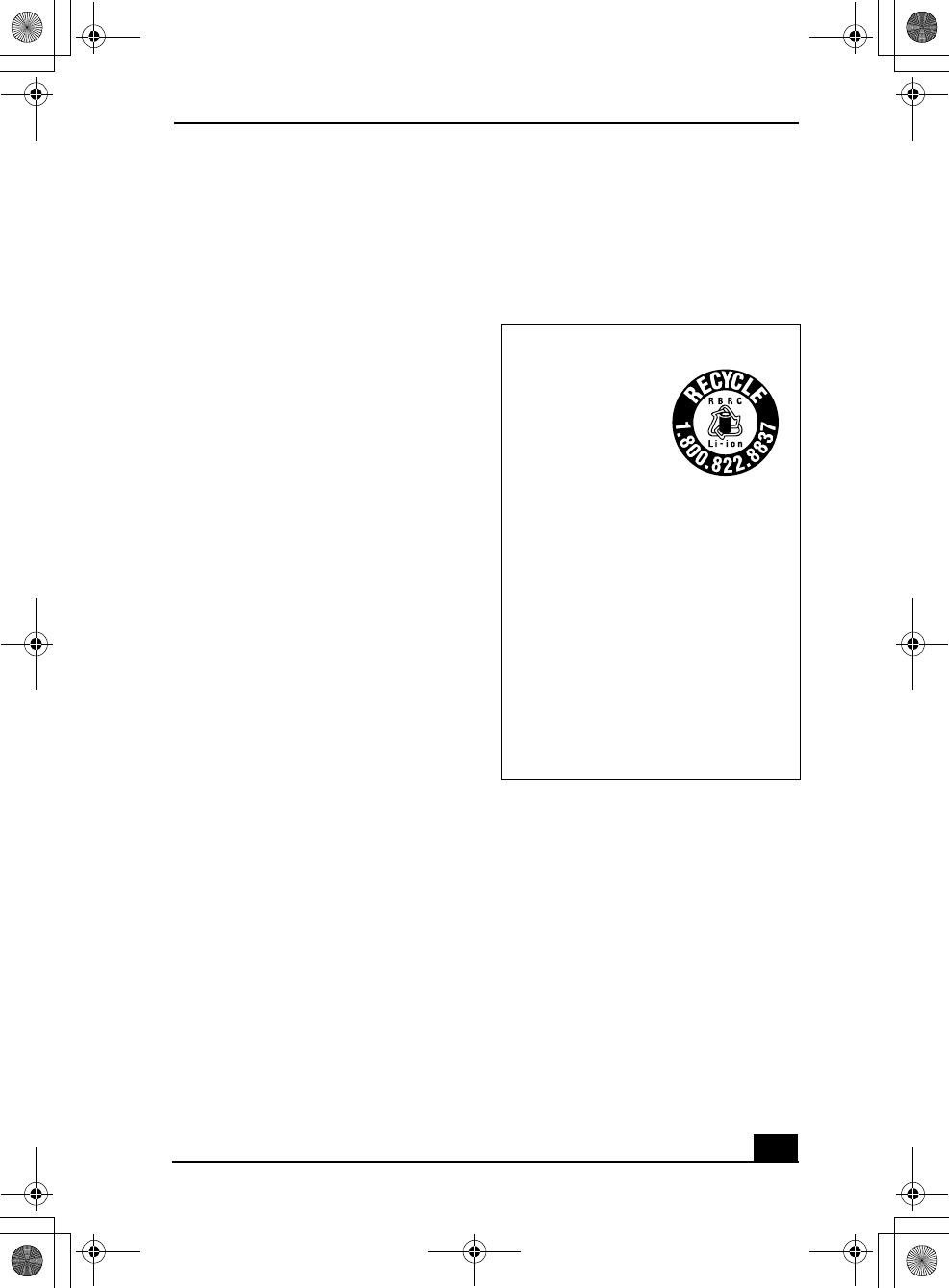
Notice to Users
11
This device and its antenna(s) must not be co-
located or operating with any other antenna or
transmitter. Users are not permitted to modify
this transmitter device. Any unauthorized
change made to this device could void your
authority to operate this device.
Telephone Consumer
Protection Act of 1991
(United States)
The Telephone Consumer Protection Act of
1991 makes it unlawful for any person to use a
computer or other electronic device, including
FAX machines, to send any message unless
such message clearly contains in a margin at the
top or bottom of each transmitted page or on the
first page of the transmission, the date and time
it is sent and an identification of the business or
other entity, or other individual sending the
message, and the telephone number of the
sending machine or such business, other entity,
or individual. (The telephone number provided
may not be a 900 number or any other number
for which charges exceed local or long-distance
transmission charges.)
In order to program this information into your
facsimile machine, see your fax software
documentation.
Telephone Consumer
Guidelines (Canada)
Please refer to your telephone directory under
‘Privacy Issues’ and/or ‘Terms of Service.’ For
more detailed information, please contact:
CRTC
Terrasses de la Chaudière, Tour centrale
1 promenade du Portage, 5 étage Hull
PQ K1A 0N2.
This Class B digital apparatus complies with
Canadian ICES-003.
Cet appareil numérique de la classe B est
conforme à la norme NMB-003 du Canada.
RECYCLING LITHIUM ION
BATTERIES
RECYCLING
LITHIUM-ION
BATTERIES
Lithium-Ion
batteries are
recyclable.
You can help
preserve our
environment by
returning your used
rechargeable
batteries to the
collection and
recycling location
nearest you.
For more information regarding recycling of
rechargeable batteries, call toll free 1-800-
822-8837, or visit http://www.rbrc.org/.
Caution: Do not handle damaged or leaking
Lithium-Ion batteries.
Fuji3.book Page 11 Monday, December 15, 2003 6:34 PM
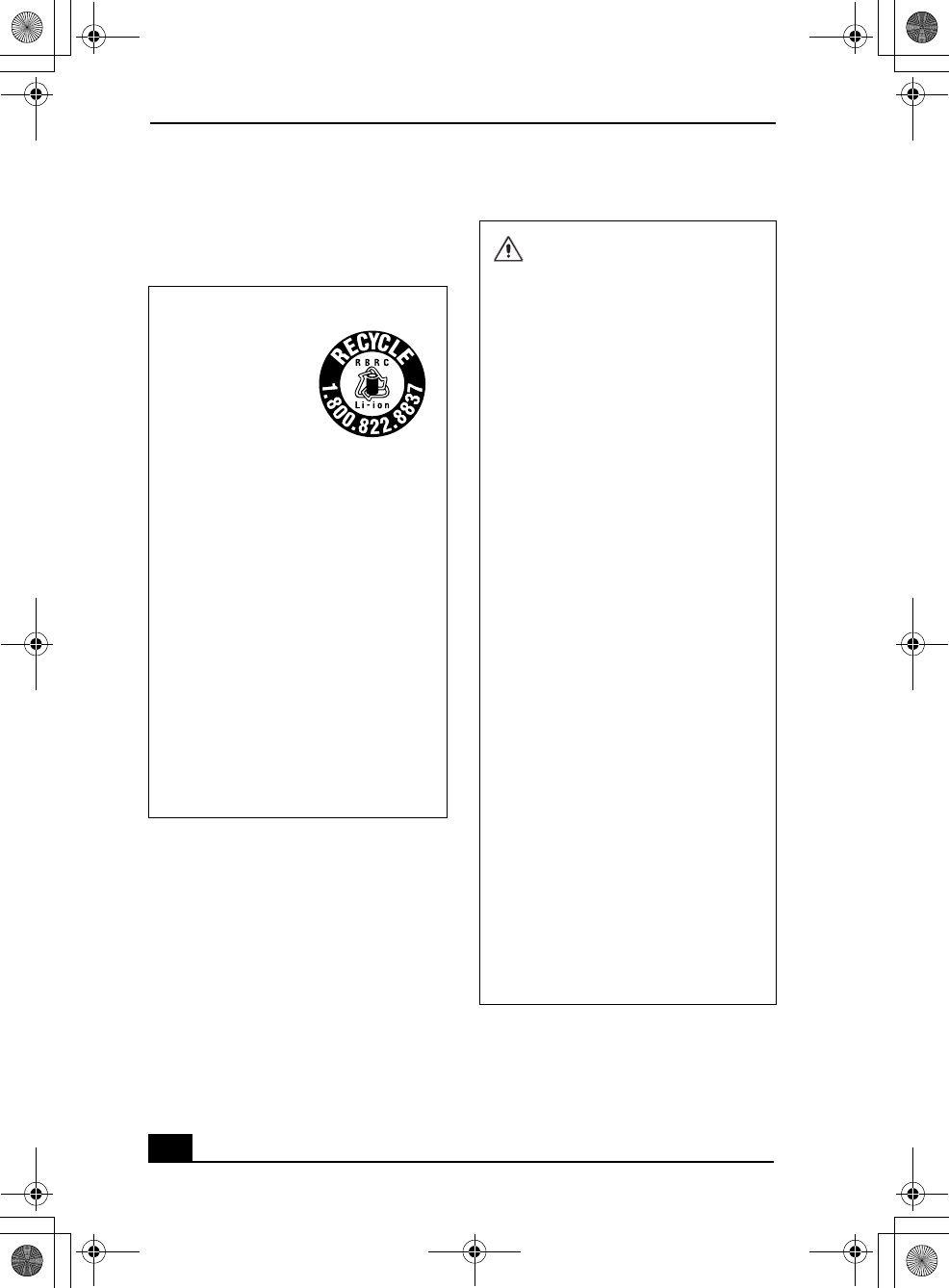
VAIO® Computer Quick Start
12
RECYCLAGE DES
ACCUMULATEURS AUX
IONS DE LITHIUM
RECYCLAGE DES
ACCUMULATEU
RS AUX IONS DE
LITHIUM
Les accumulateurs
aux ions de lithium
sont recyclables.
Vous pouvez
contribuer à
préserver
l’environnement en
rapportant les piles
usées dans un point
de collection et
recyclage le plus
proche.
Pour plus d’informations sur le recyclage
des accumulateurs, téléphonez le numéro
gratuit 1-800-822-8837 (Etats-Units et
Canada uniquement), ou visitez
http://www.rbrc.org/.
Avertissment: Ne pas utiliser des
accumulateurs aux ions de lithium qui sont
endommagées ou qui fuient.
Do not handle damaged or leaking
lithium ion batteries.
Danger of explosion if battery is
incorrectly replaced. Replace
only with the same or equivalent
type recommended by the
manufacturer. Discard used
batteries according to the
manufacturer’s instructions.
The battery pack used in this
device may present a fire or
chemical burn hazard if
mistreated. Do not disassemble,
heat above 140°F (60°C) or
incinerate. Dispose of used
battery promptly. Keep away from
children.
Ne pas utiliser des batteries au
lithium ionisé qui sont
endommagées ou qui fuient.
Une batterie non conforme
présente un danger d'explosion.
La remplacer seulement par une
batterie identique ou de type
équivalent recommandé par le
fabricant. Évacuer les batteries
usées selon les directives du
fabricant.
La manutention incorrecte du
module de batterie de cet
appareil présente un risque
d'incendie ou de brûlures
chimiques. Ne pas démonter,
incinérer ou exposer à une
température de plus de 60°C.
Évacuer promptement la batterie
usée. Garder hors de portée des
enfants.
Fuji3.book Page 12 Monday, December 15, 2003 6:34 PM
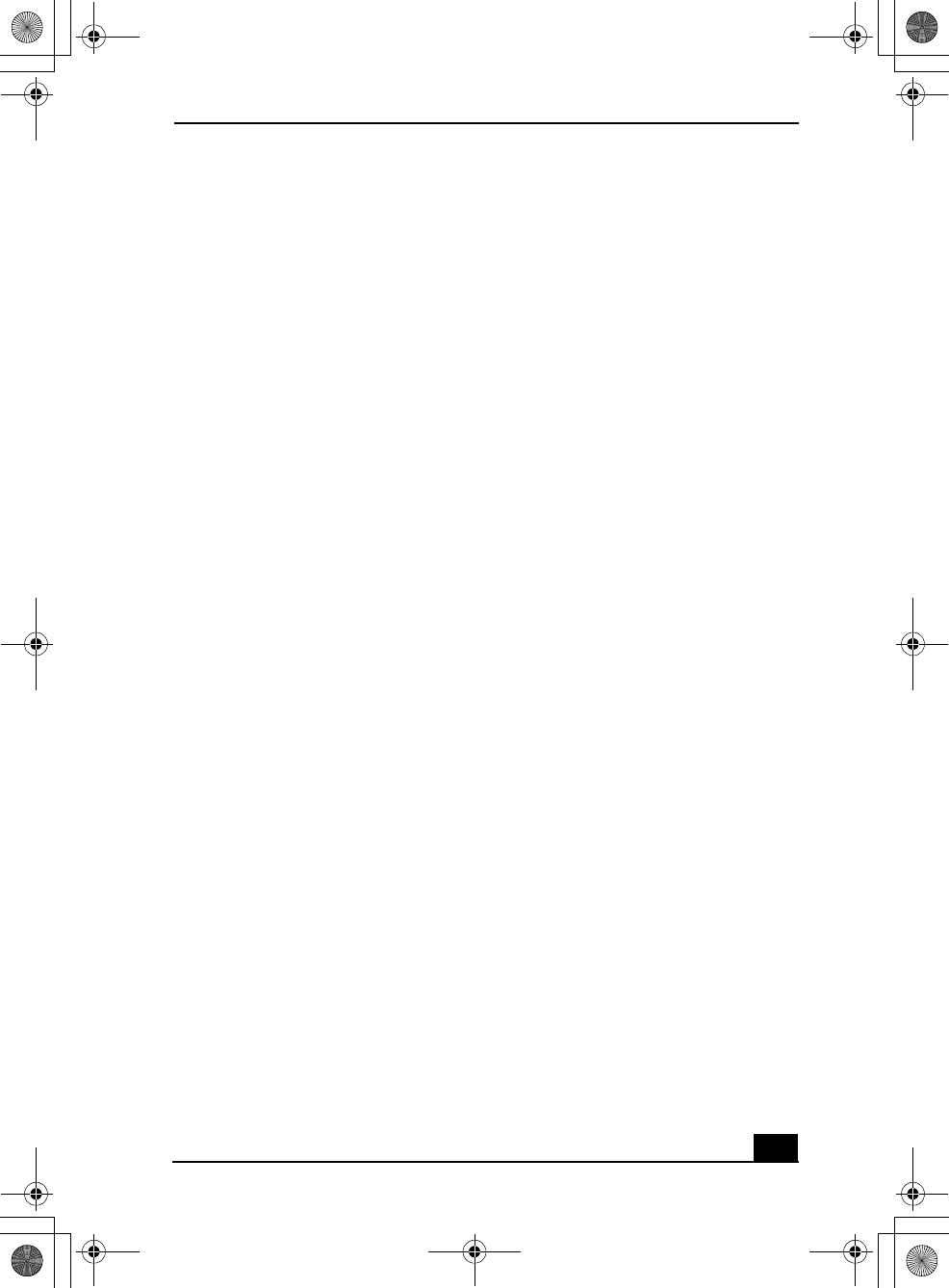
Notice to Users
13
INDUSTRY CANADA NOTICE
NOTICE: This equipment meets the applicable
Industry Canada Terminal Equipment Technical
Specifications.
The Ringer Equivalence Number (REN) for this
terminal equipment is 0.2. The REN assigned to
each terminal equipment provides an indication
of the maximum number of terminals allowed
to be connected to a telephone interface. The
termination on an interface may consist of any
combination of devices subject only to the
requirement that the sum of the Ringer
Equivalence Numbers of all the devices does
not exceed five.
AVIS D’INDUSTRIE CANADA
REMARQUE: Cet équipement est conforme
aux Spécifications Techniques des Équipements
Terminaux d’Industrie Canada en vigueur.
Le Nombre Équivalent de Sonneries (REN) de
cet équipement terminal est 0,2. Le REN
attribué à chaque équipement terminal indique
le nombre maximum de terminaux que l’on
peut connecter à une interface téléphonique. Il
est possible de raccorder à une interface
plusieurs combinaisons d’appareils, mais la
somme des Nombres Équivalents de Sonneries
de tous ces appareils ne doit pas dépasser cinq.
Fuji3.book Page 13 Monday, December 15, 2003 6:34 PM
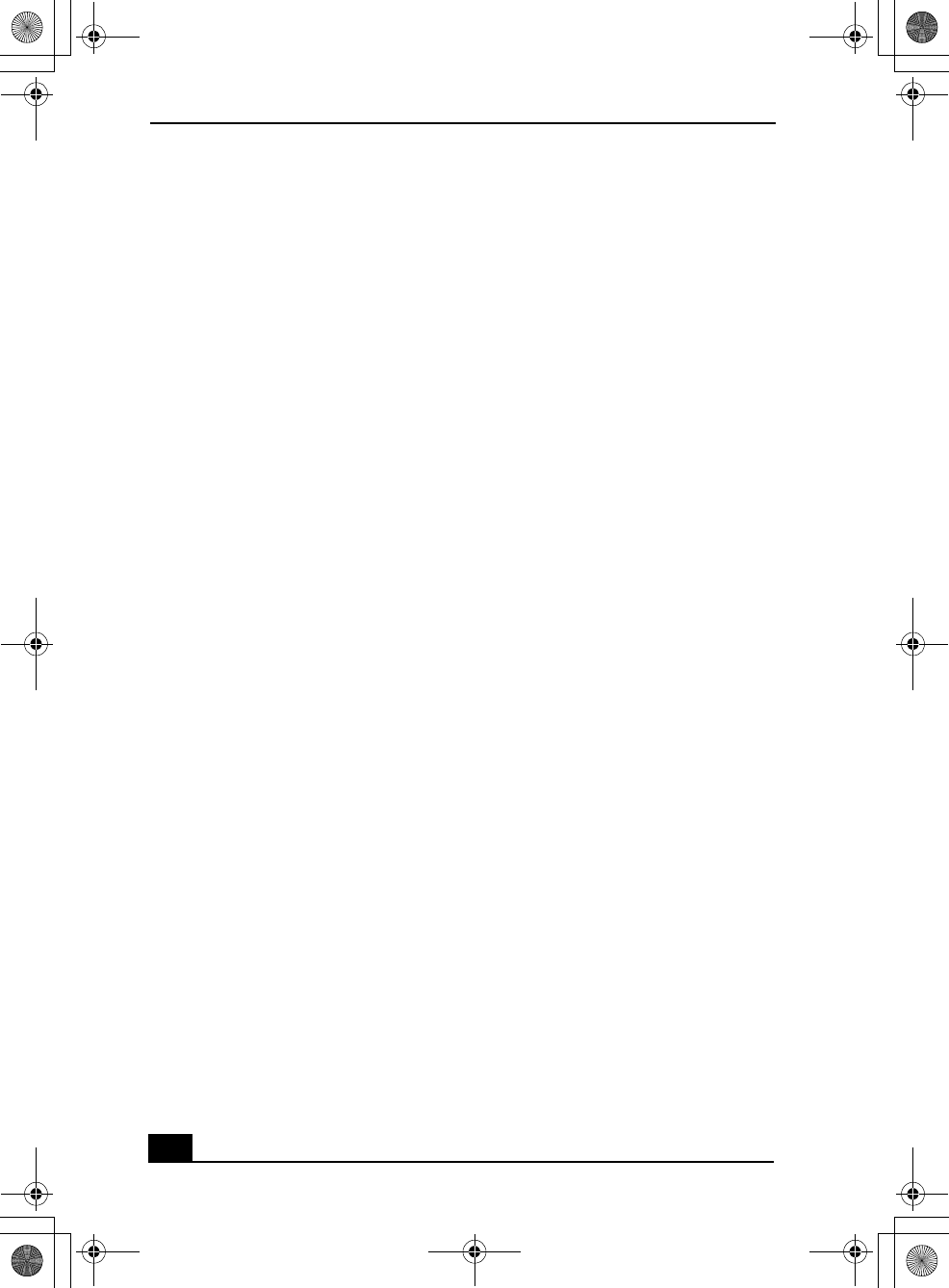
VAIO® Computer Quick Start
14
Fuji3.book Page 14 Monday, December 15, 2003 6:34 PM
Canadian Regulatory Information:
Wireless Devices (IC RSS-210)
Operation is subject to the following two conditions:
(1) this device may not cause interference,
and (2) this device must accept any interference,
including interference that may cause undesired
operation of the device.
To prevent radio interference to the licensed service,
this device is intended to be operated indoors
and away from windows to provide maximum shielding.
Equipment (or its transmit antenna) that
is installed outdoors is subject to licensing.
The term “IC:” before the certification/registration
number only signifies that the Industry Canada
technical specifications were met.
The installer of this radio equipment must ensure that
the antenna is located or pointed such that it
does not emit RF field in excess of Health Canada
limits for the general population; consult
Safety Code 6, obtainable from Health Canada’s
Web site: www.hc-sc.gc.ca/rpb.
L’utilisation de ce dispositif est autorisee seulement
aux conditions suivantes: (1) il ne doit pas
produire de brouillage et (2) l’utilisateur du dispositif
doit etre pret a accepter tout brouillage
radioelectrique recu, meme si ce brouillage est
susceptible de compromettre le fonctionnement du
dispositif.
Pour empecher que cet appareil cause du brouillage
au service faisant l’objet d’une licence, il doit
etre utilise a l’interieur et devrait etre place loin des
fenetres afin de fournir un ecran de blindage
maximal. Si le materiel (ou son antenne d’emission)
est installe a l’exterieur, il doit faire l’objet
d’une licence.
L’expression “IC:” avant le numero d’homologation/
enregistrement signifie seulement que les
specifications techniques d’Industrie Canada ont
ete respectees.
L'installateur du present materiel radio doit s'assurer
que l'antenne est situee ou pointee de
maniere a ce que cette derniere n'emette pas de
champs radioelectriques superieurs aux limites
specifiees par Sante Canada pour le grand public;
consulter le Code de securite 6, disponible sur
le site Web de Sante Canada, a l'adresse suivante:
www.hc-sc.gc.ca/rpb.
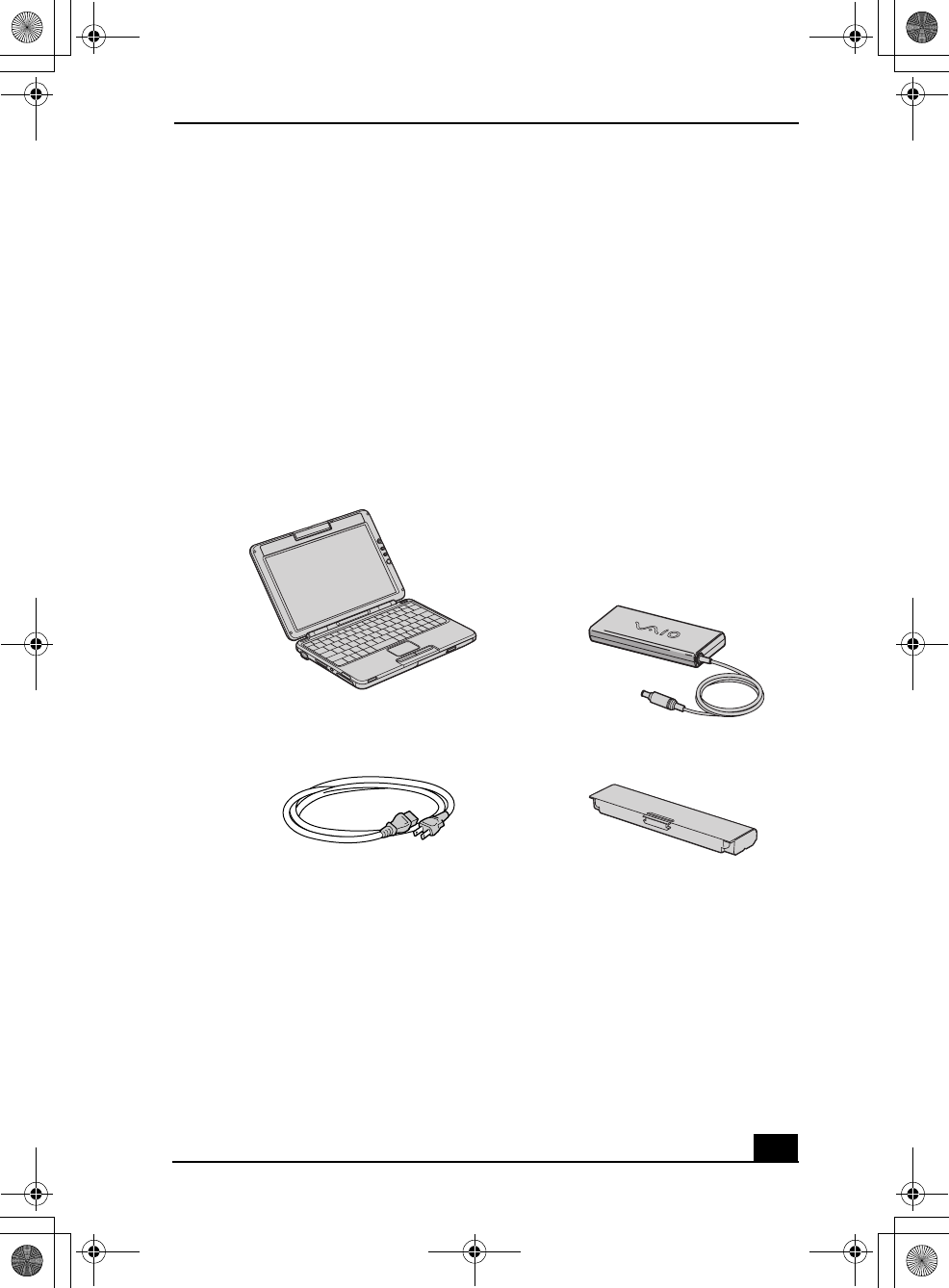
Setting Up
15
Setting Up
Congratulations on your purchase of the Sony VAIO® computer. Sony has
combined leading-edge technology in audio, video, computing, and
communications to provide state-of-the-art personal computing.
Unpacking Your Computer
Main Unit
AC Adapter
Power Cord Rechargeable Battery
Fuji3.book Page 15 Monday, December 15, 2003 6:34 PM
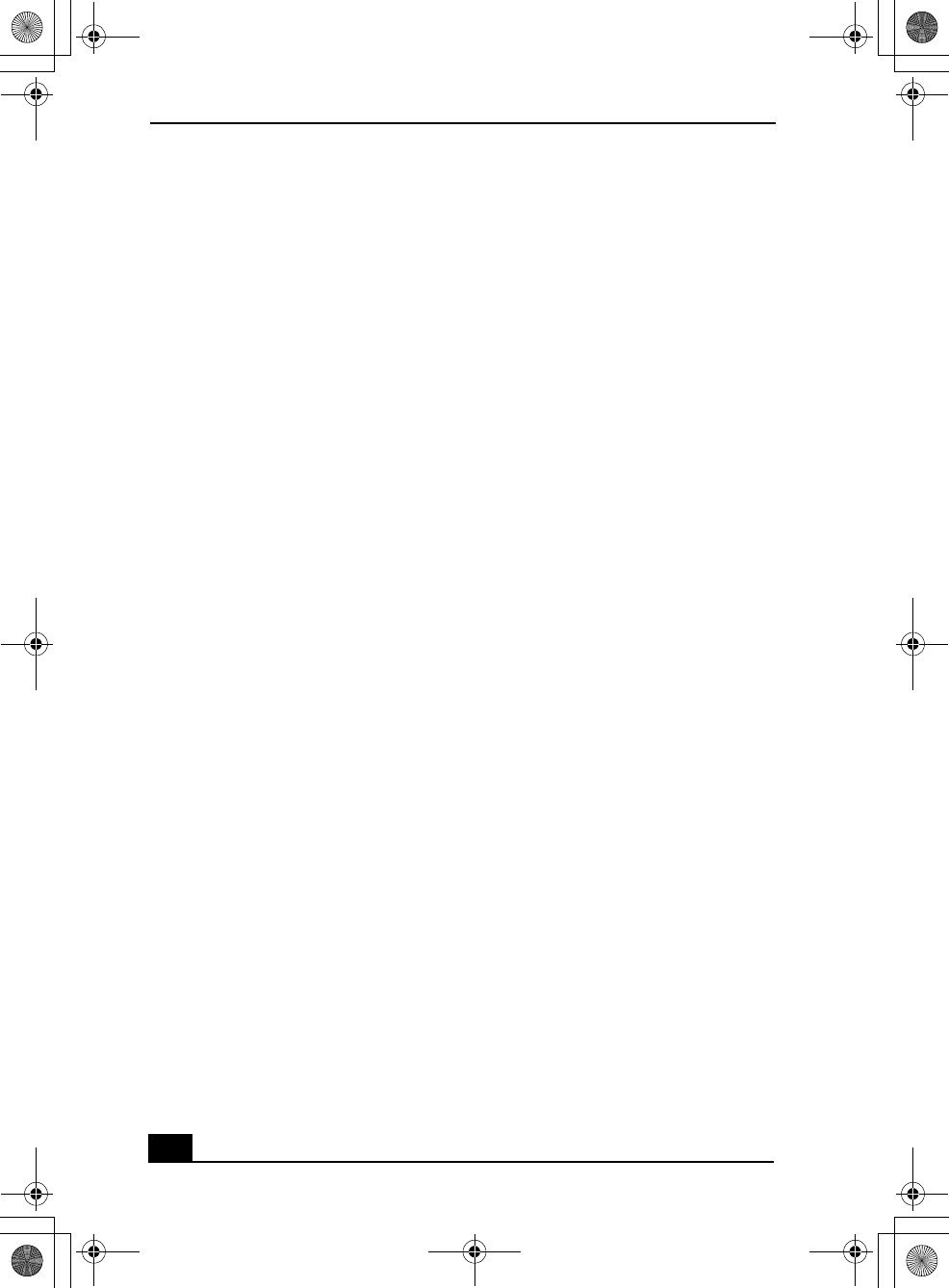
VAIO® Computer Quick Start
16
VAIO Computer Documents
❑VAIO® Computer User Guide — A searchable on-screen help file that
contains detailed information on how to use your new computer. See
“Locating Your VAIO Computer User Guide” on page 29 for more
information.
❑VAIO® Computer Quick Start (this document) — Contains information
on unpacking and setting up your computer for immediate use.
❑VAIO® Computer Specifications — An electronic file that details the
hardware specifications and lists the installed programs on your computer.
Go to http://www.sony.com/pcsupport for more information.
Software CDs
❑Depending on the model you purchased, a selection of program CDs may be
included with your computer.
About System Recovery operations
Computers with the Microsoft® Windows® XP operating system feature a hard
disk drive recovery process that eliminates the need for Recovery CDs.
Fuji3.book Page 16 Monday, December 15, 2003 6:34 PM
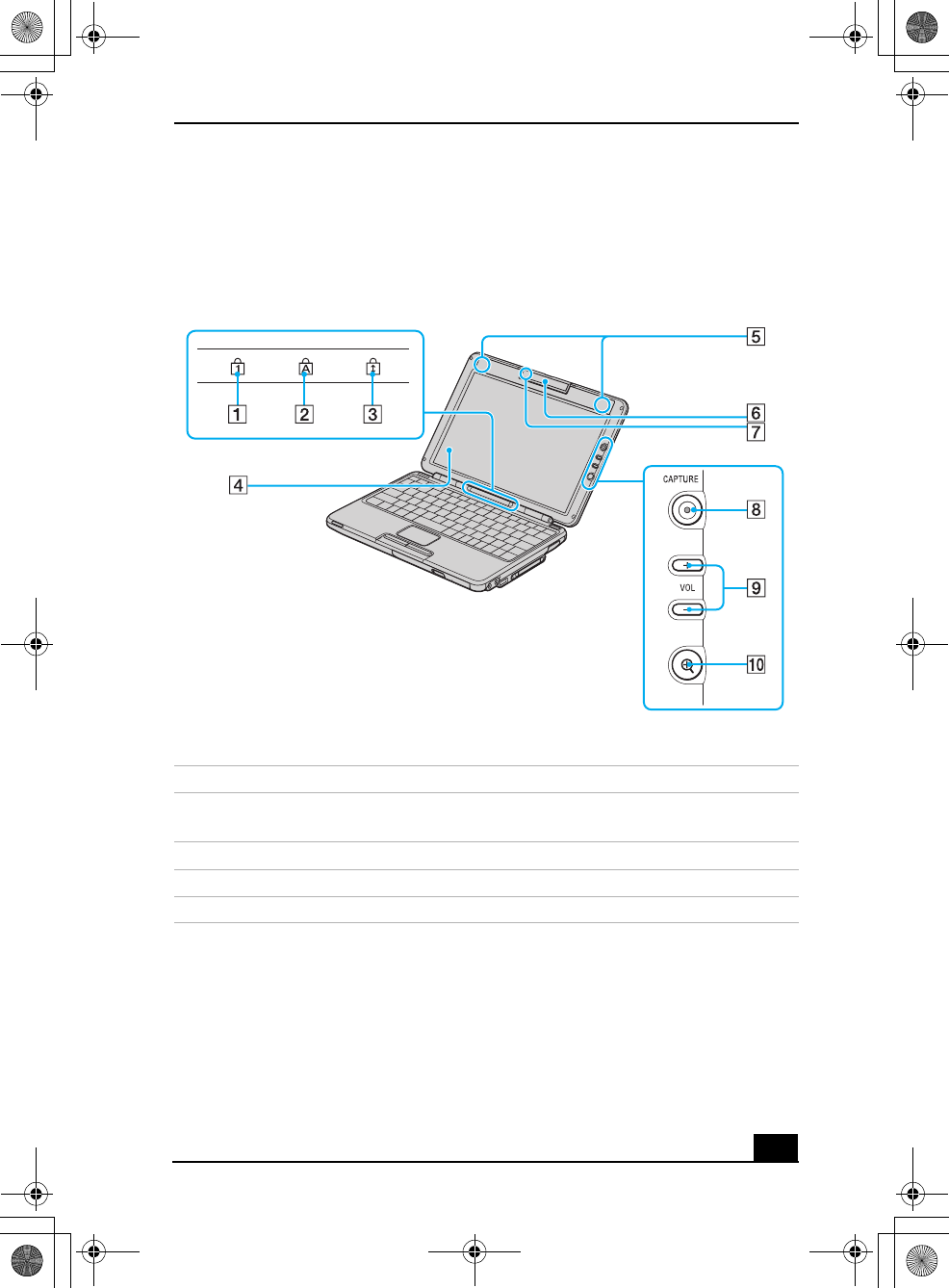
Locating Controls and Ports
17
Locating Controls and Ports
Front (Upper Panel)
1Num lock indicator 6MOTION EYE® camera
2Caps lock indicator 7MOTION EYE® camera
indicator
3Scroll lock indicator 8CAPTURE button
4Computer screen (LCD) 9Vo lu me b ut t on s
5Speakers 10 Magnify button
Fuji3.book Page 17 Monday, December 15, 2003 6:34 PM
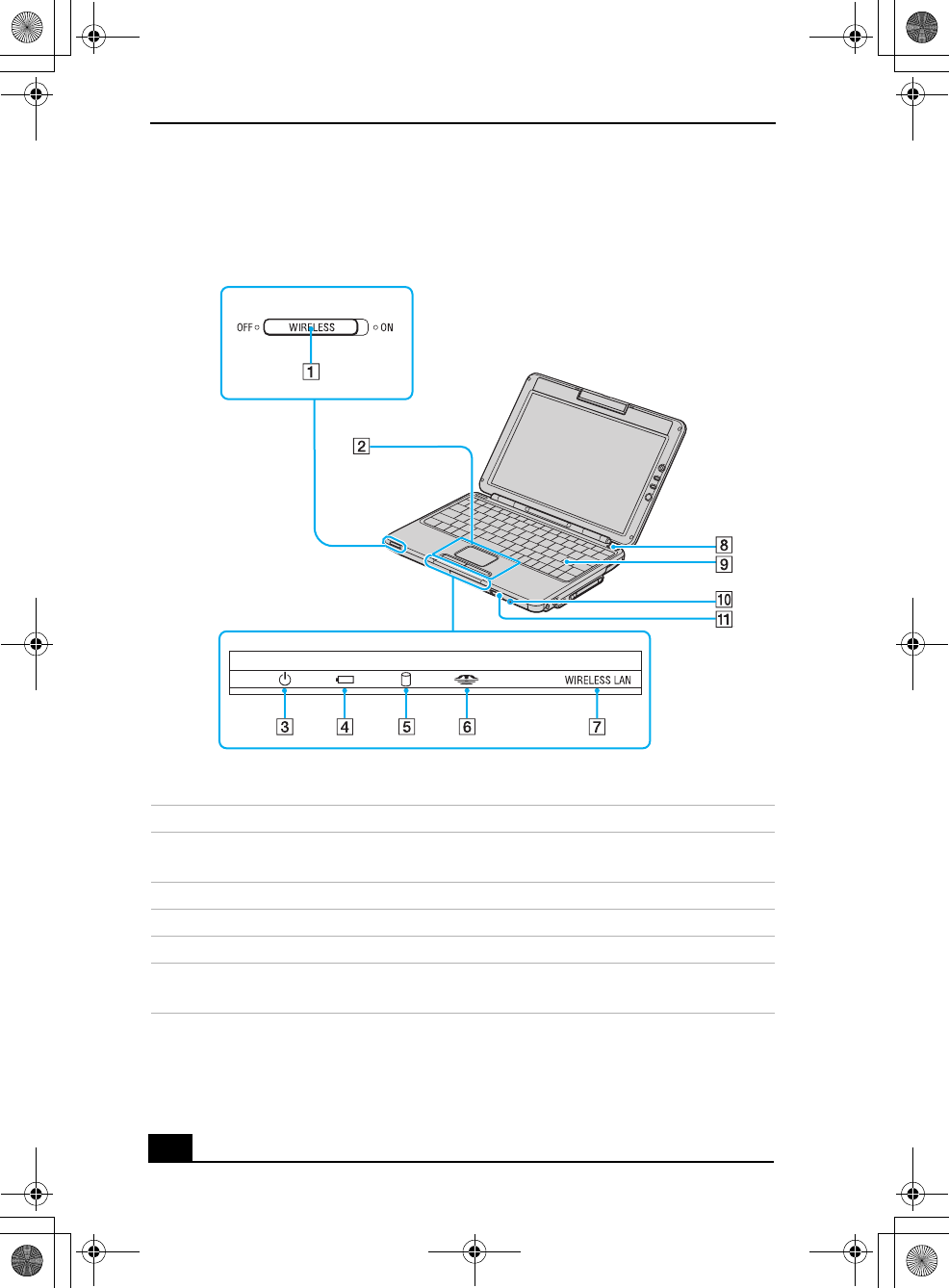
VAIO® Computer Quick Start
18
Front (Lower Panel)
1Wireless LAN switch 7Wireless LAN indicator
2Touch pad and
left and right buttons
8Power button
3Power indicator 9Keyboard
4Battery indicator 10 Optical drive manual eject hole
5Hard disk drive indicator 11 Optical drive and eject button
6Memory Stick® media
indicator
Fuji3.book Page 18 Monday, December 15, 2003 6:34 PM

Locating Controls and Ports
19
Back
1 DC IN port
2 Battery port
Opening Rubber Tabs
✍Gently pull the rubber tab away from the computer to find the hidden ports and jacks.
Make sure not to tear the rubber tab off.
Rubber tab
Rubber tab
Fuji3.book Page 19 Monday, December 15, 2003 6:34 PM

VAIO® Computer Quick Start
20
Left
1 VGA monitor port 4 i.LINK® (IEEE 1394) S400 port
2Air vent 5Peripheral device DC OUT port
3 USB port 6Memory Stick® media slot
Fuji3.book Page 20 Monday, December 15, 2003 6:34 PM

Locating Controls and Ports
21
Right
1 Headphones jack 5PC Card slot
2 Microphone jack 6 Network (Ethernet) port
3 USB port 7 Modem jack
4PC Card eject button
Only connect 10BASE-T or 100BASE-TX cables to the Network (Ethernet)
port. Do not connect any other type of network cable or any telephone line to
this port. Connecting cables other than those listed above may result in an
electric current overload and could cause a malfunction, excessive heat, or fire
in the port. To connect the unit to a network, refer to your online VAIO®
Computer User Guide or contact your network administrator. See “Locating
Your VAIO Computer User Guide” on page 29 for more information.
Fuji3.book Page 21 Monday, December 15, 2003 6:34 PM
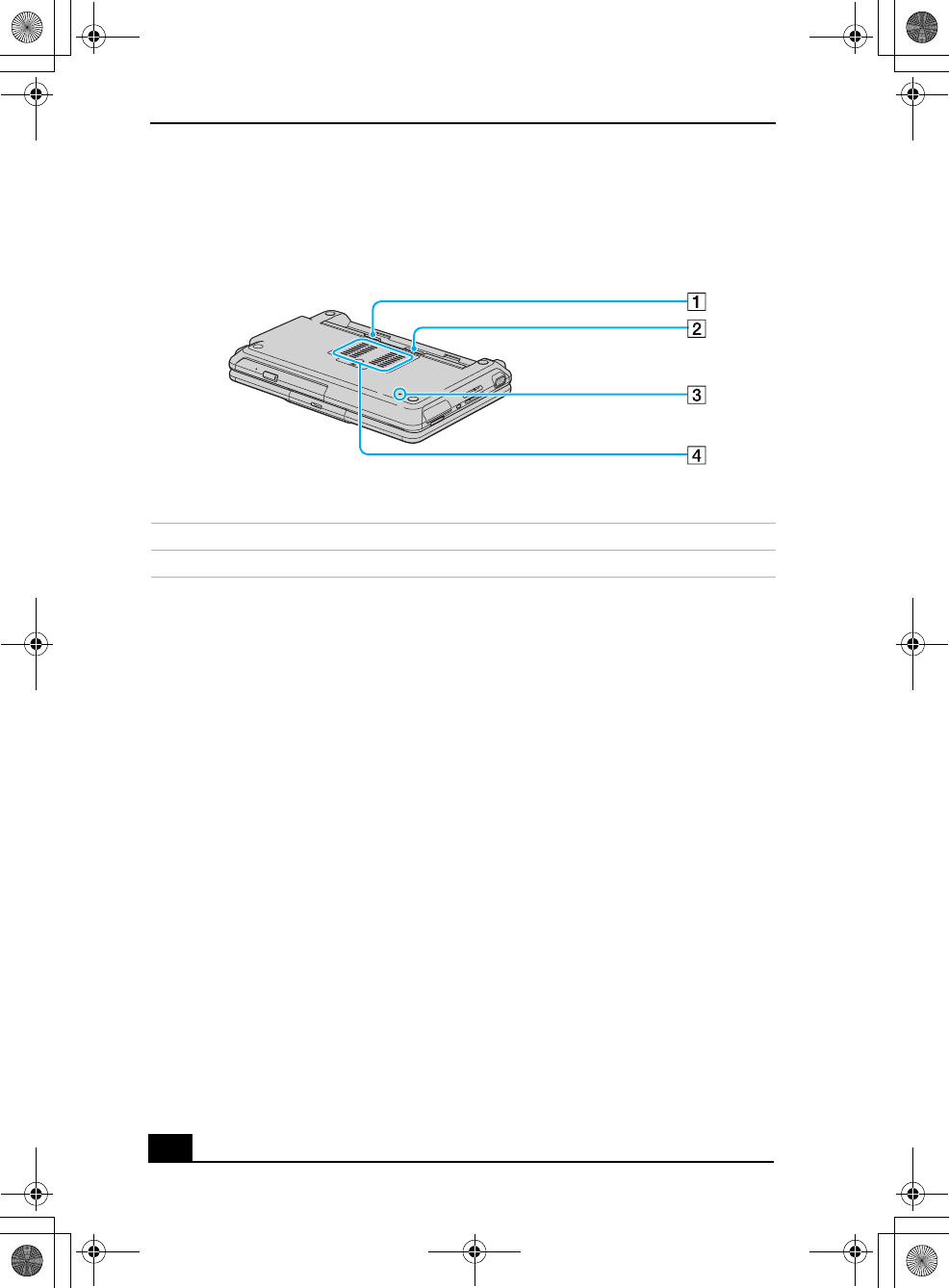
VAIO® Computer Quick Start
22
Bottom
1UNLOCK/LOCK latch 3Reset button
2RELEASE latch 4Ventilation slots
Fuji3.book Page 22 Monday, December 15, 2003 6:34 PM
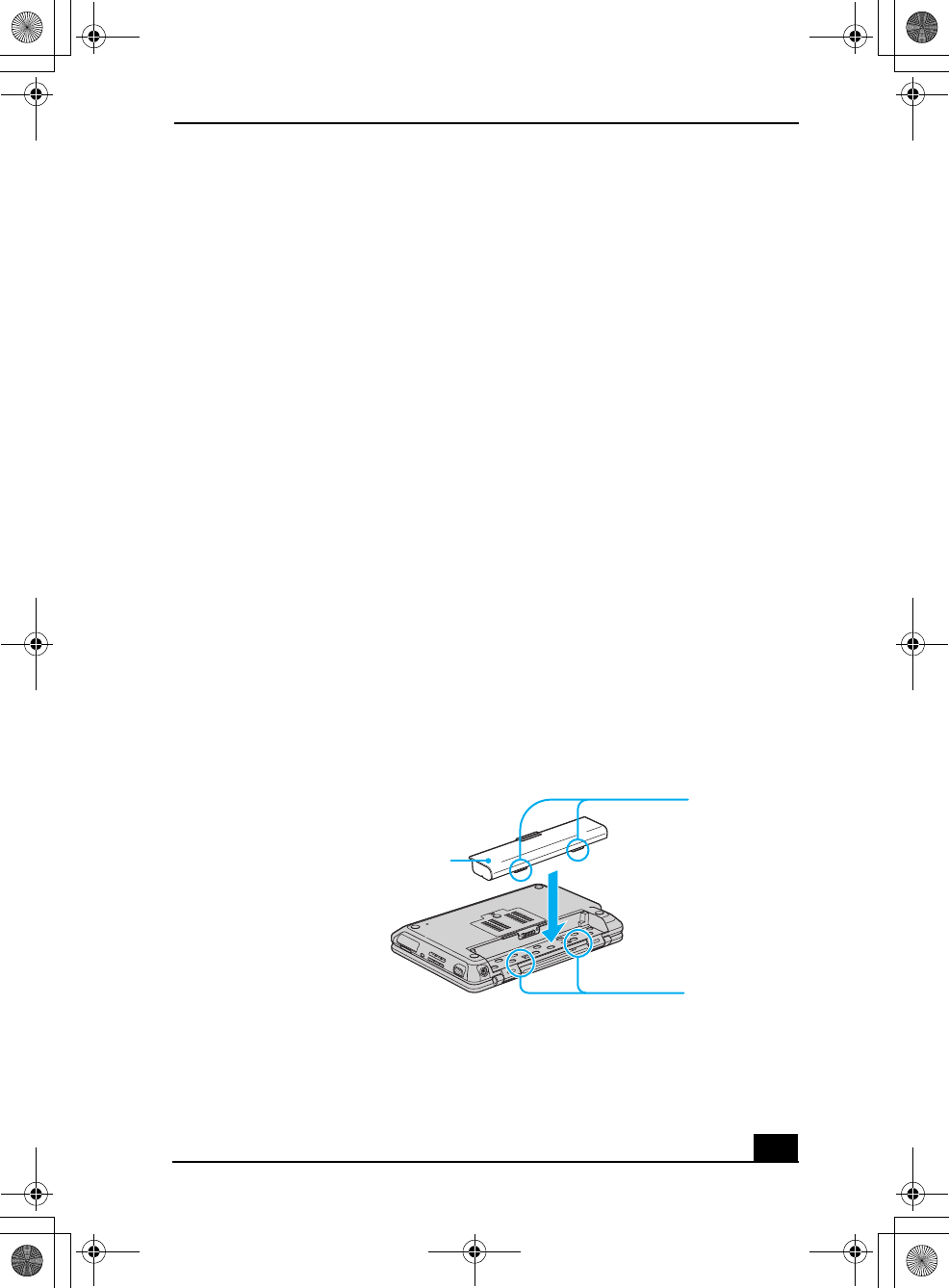
Getting Started
23
Getting Started
The supplied battery is not charged when you unpack it. To charge it for future
use, install the battery, and then connect the AC adapter to power your computer.
The battery charges from AC power regardless if the computer is on or off. See
the “Powering Your Computer” chapter of your on-screen VAIO® Computer
User Guide for more information.
Turning On Your Computer
To turn on your computer
1Turn the computer over, and slide the UNLOCK/LOCK latch on the bottom
of the computer to the UNLOCK position.
2Align the tabs on the battery with the grooves on the back of the computer,
and slide the battery into the computer until it clicks into place.
3Slide the UNLOCK/LOCK latch into the LOCK position to secure the
battery.
Inserting the Battery
Battery
Grooves
Tabs
Fuji3.book Page 23 Monday, December 15, 2003 6:34 PM

VAIO® Computer Quick Start
24
4Plug the AC adapter cable into the DC IN port.
5Plug the power cord into the AC adapter and an AC outlet.
.
6Lift the cover while holding the bottom of the computer firmly.
Connecting the AC Adapter to the Computer
✍Use only the supplied AC adapter with your computer.
✍When opening or lifting the computer, avoid exerting any kind of pressure to the LCD
screen or the edges of the LCD screen. Open the computer by holding the base with
one hand and gently lifting the cover with the other. Do not hold the computer by the
LCD screen.
DC IN port
Power cord
(supplied)
(supplied)
AC adapter
Fuji3.book Page 24 Monday, December 15, 2003 6:34 PM
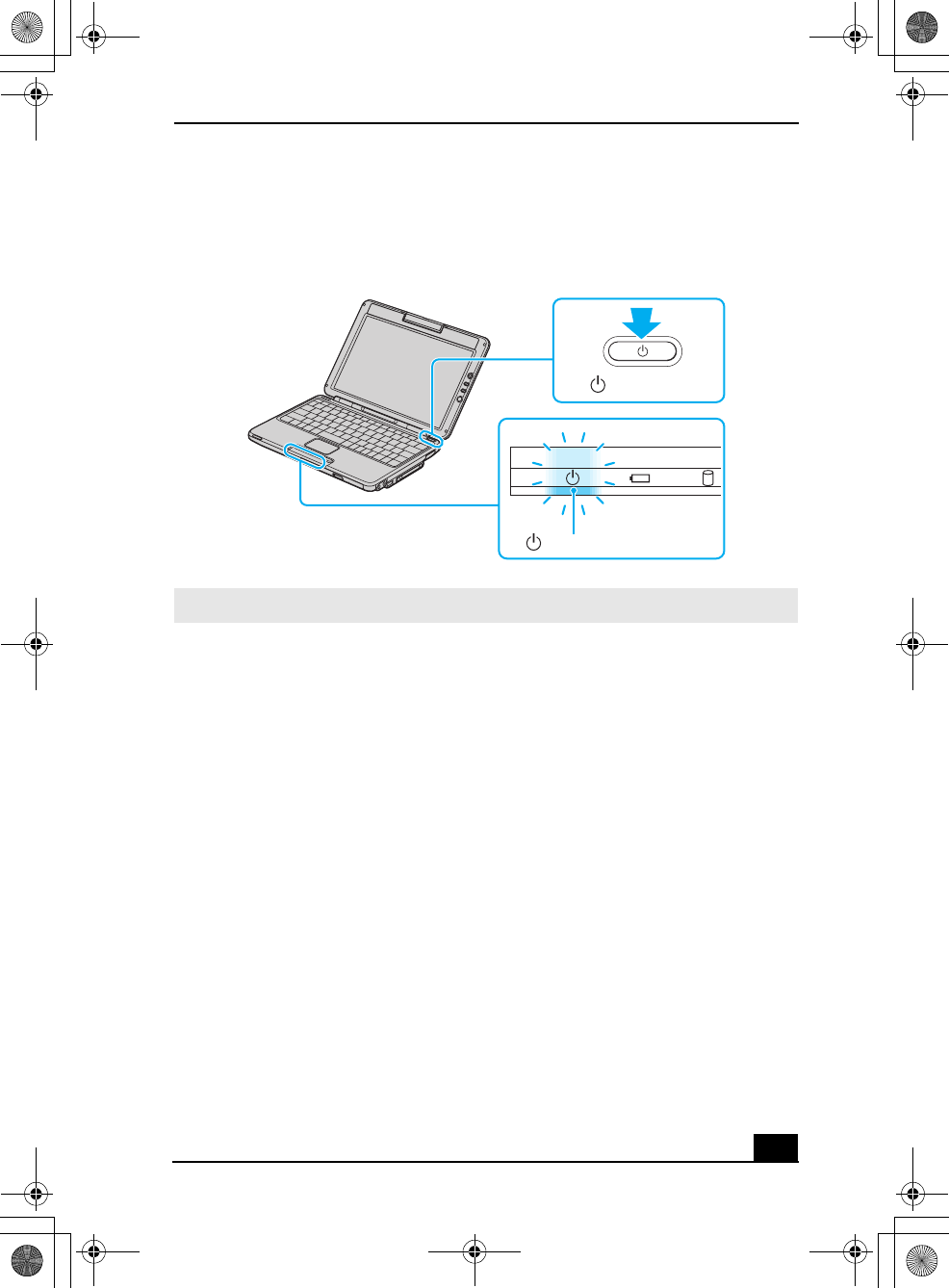
Turning On Your Computer
25
7Press the power button until the power indicator turns on.
Turning on the Computer
✍If you continue to hold the power button, the computer turns off.
Power button
Power indicator
Fuji3.book Page 25 Monday, December 15, 2003 6:34 PM
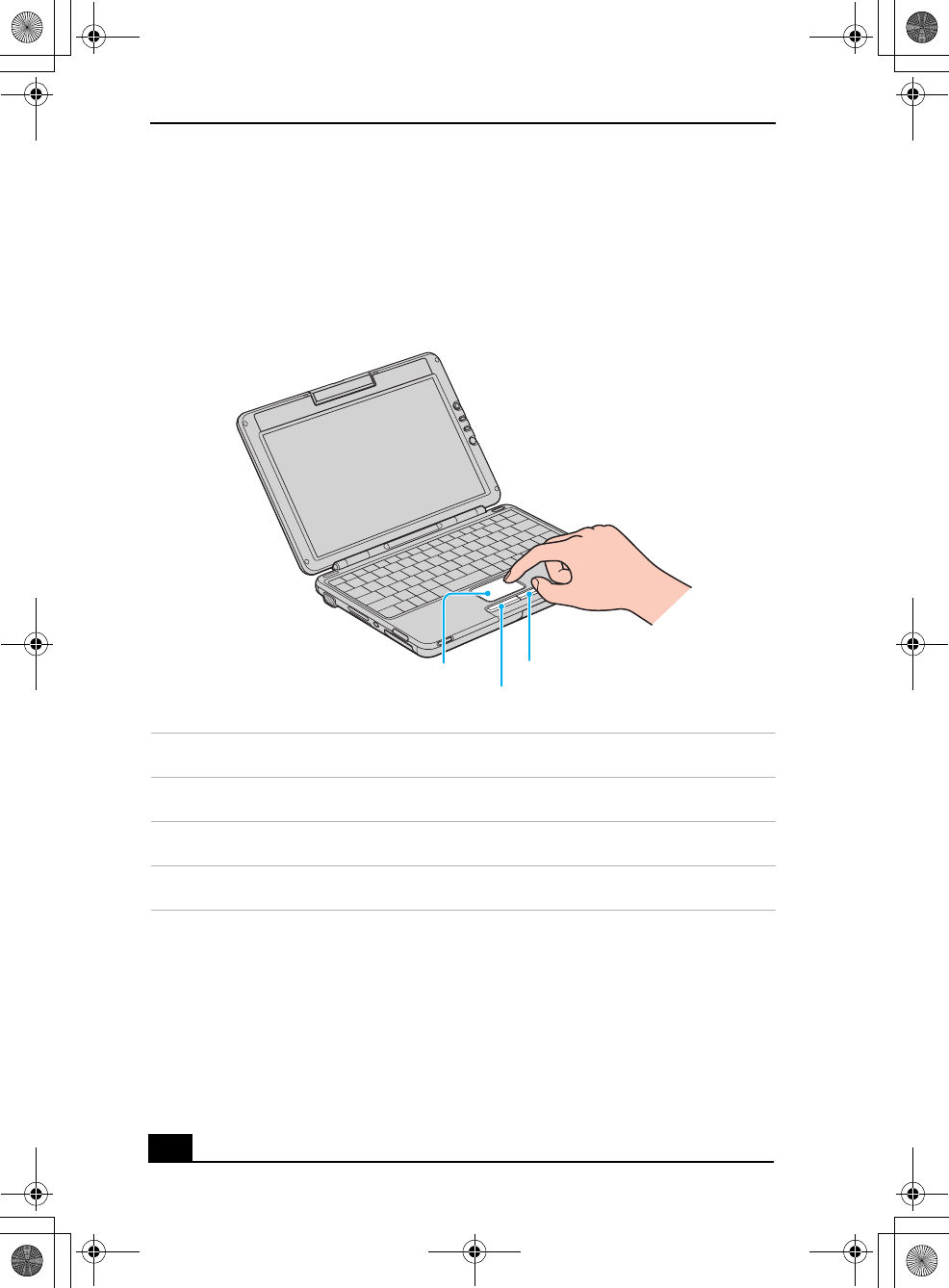
VAIO® Computer Quick Start
26
Using the Touch Pad
The computer contains a pointing device called a touch pad. You can point to,
select, drag, and scroll objects on the screen using the built-in touch pad.
Locating the Touch Pad
Touch Pad Action Description
Sliding one finger Equivalent to using a mouse to place the pointer on an item.
Tapping once Equivalent to pressing the left button once.
Tapping twice Equivalent to pressing the left button twice.
Touch pad
Left button
Right button
Fuji3.book Page 26 Monday, December 15, 2003 6:34 PM

Registering Your Computer
27
Registering Your Computer
Take advantage of Sony’s commitment to quality customer support and receive
these benefits by registering your computer:
❑Sony Customer Support — Talk to a support representative to troubleshoot
problems you may have with your computer.
❑Limited Warranty Extension — Protect your investment. See the Warranty
Card for more details.
❑Product Information Notification — By giving Sony your contact
information, you will enable Sony to reach you regarding performance
updates and upgrades.
Sliding one finger
while pressing the
left button
Equivalent to using the mouse to drag an item.
Moving your finger
along the right edge
of the touch pad
Equivalent to scrolling vertically. (The scroll function is
available only with programs that support a touch pad scroll
feature.)
Moving your finger
along the bottom to
scroll horizontally
Equivalent to scrolling horizontally. (The scroll function is
available only with programs that support a touch pad scroll
feature.)
✍You are prompted to register your computer the first time you turn on the unit. Follow
the on-screen instructions to complete the registration process. If you are not able to
register your computer during the first session, you are provided with additional
registration opportunities later.
Touch Pad Action Description
Fuji3.book Page 27 Monday, December 15, 2003 6:34 PM

VAIO® Computer Quick Start
28
Locating Your VAIO Computer User Guide
The on-screen VAIO® Computer User Guide is a searchable help file that
contains detailed information on how to use your new computer.
To open the user guide
1Click Start on the Windows® taskbar, and then click Help and Support.
The Help and Support Center window appears, displaying information
about your VAIO® computer and Microsoft® Windows® operating system.
2Click VAIO User Guide in the Pick a Help topic column. A second Help
and Support Center window appears, which offers information about your
computer.
Locating the VAIO User Guide
User Guide Link
Fuji3.book Page 28 Monday, December 15, 2003 6:34 PM
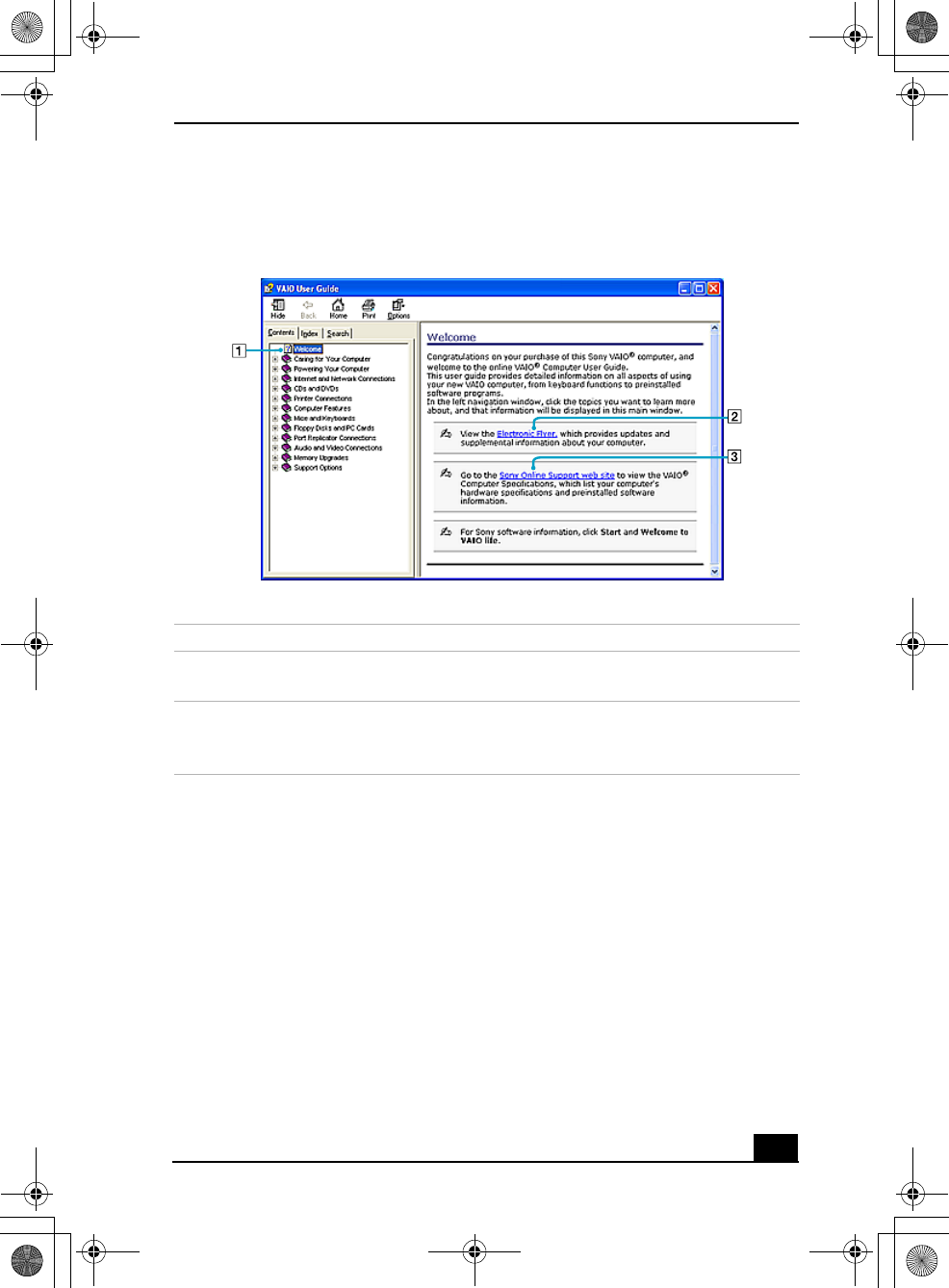
Locating Your VAIO Computer User Guide
29
VAIO User Guide Window
1User guide table of contents List of computer help topics
2Link to Electronic Flyer List of updates and supplemental
information
3Link to the Sony Online
Support Web site
List of your computer’s hardware
specifications and preinstalled software
information (Internet access required)
Fuji3.book Page 29 Monday, December 15, 2003 6:34 PM
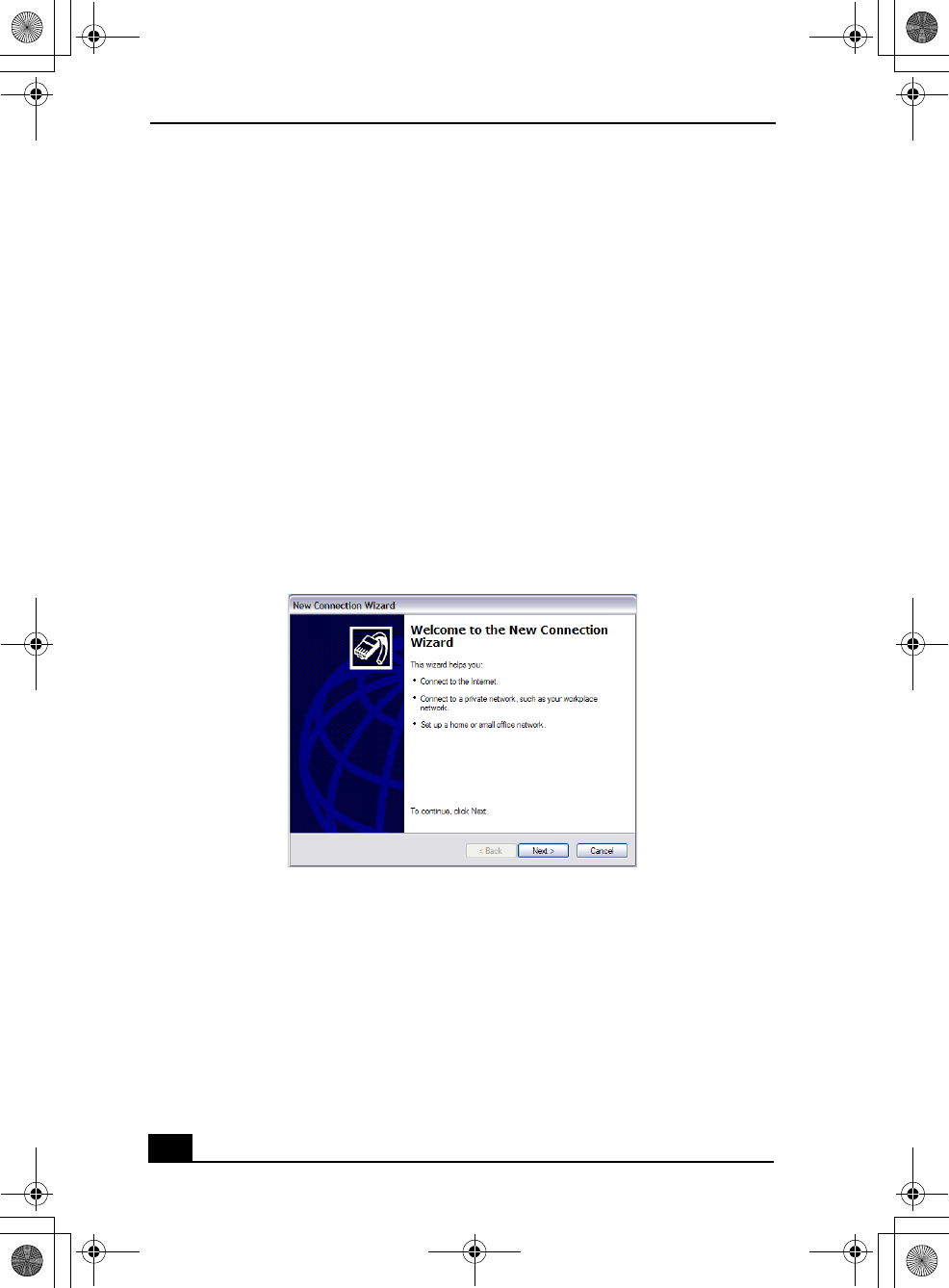
VAIO® Computer Quick Start
30
Setting Up A Dial-Up Connection
The Connection Wizard guides you through the process of choosing an Internet
Service Provider (ISP) or setting up an existing account, and connecting to the
Internet.
To set up a dial-up connection
1Connect a telephone cable to your computer. See “Setting up a dial-up
Internet connection” in the Internet and Network Connections chapter of
your on-screen VAIO® Computer User Guide.
2Click Start, point to All Programs, Accessories, Communications, and
then click New Connection Wizard. The New Connection Wizard
appears.
3Click Next.
4If it is not already selected, click Connect to the Internet.
5Click Next.
6Follow the on-screen instructions.
New Connection Wizard
Fuji3.book Page 30 Monday, December 15, 2003 6:34 PM

Turning Off Your Computer
31
Turning Off Your Computer
Using the power button to turn off your computer may result in loss of data.
Follow the steps below to properly turn off your computer and avoid losing data.
To turn off your computer
1Close all operations.
2Click Start on the Windows® taskbar.
3Click Turn Off Computer at the bottom of the Start menu to display the
Turn off computer window, and select Turn Off.
4Wait for your computer to turn off automatically. The computer is off when
the power indicator turns off.
✍Respond to any prompts warning you to save documents.
✍During a period of inactivity, you can conserve battery life by using power saving
modes. See “Conserving Battery Power” in the VAIO® Computer User Guide for more
information.
✍If you are unable to turn off the computer, press and hold the power button until the
computer turns off. Data that is not saved when the computer is turned off may be
lost.
Fuji3.book Page 31 Monday, December 15, 2003 6:34 PM

VAIO® Computer Quick Start
32
Fuji3.book Page 32 Monday, December 15, 2003 6:34 PM

33
VAIO Recovery Wizard Utility
System and Application Recovery CDs are not supplied with your VAIO®
computer. Your VAIO computer is equipped with the VAIO Recovery Wizard, a
fast and easy-to-use system recovery utility. This system and application
recovery utility enables you to recover preinstalled software programs, the
operating system, and to create a VAIO Recovery Media Kit.
About the VAIO Recovery Wizard utility
❑Use the several recovery options to restore your preinstalled software
programs and specific partitions on your hard disk drive.
❑Follow the instructions that guide you through several recovery options
choosing the default selections or customizing your computer's recovery.
❑Discover the advantages of recovering your computer without using CDs or
other external media.
❑Create your own Recovery Media Kit, using your purchased CD or DVD
media.
Creating a Recovery Media Kit
You can create your Recovery Media Kit using CD or DVD media* that can be
used if your system does not start. The Recovery Media Kit enables you to
reclaim the space reserved for the recovery partition (approximately 5 GB).
For more information about creating the Recovery Media Kit, see the VAIO
Recovery Options online guide:
1Click Start in the Windows® taskbar, and then click Help and
Support.
2From the VAIO Help and Support Center, click VAIO Recovery
Options.
* The number of CDs and/or DVDs required to create a Recovery Media Kit may vary,
depending on the computer model purchased.
Fuji3.book Page 33 Monday, December 15, 2003 6:34 PM

VAIO Computer Quick Start
34
Visit the Sony Online Support Web site for the latest information about using the
VAIO Recovery Wizard or Recovery Media Kit.
Go to http://www.ita.sel.sony.com/support/news/hddrecovery.html.
To purchase a VAIO Recovery Media kit
1Go to the Sony Direct Accessories and Parts Center Web site at
http://servicesales.sel.sony.com.
2Type your computer model number (for example, PCG-XXXX) in the
Search box, and click Search.
3If the Model Information page appears, click to select your computer
model.
4Follow the online instructions to order the Recovery Media Kit.
Using the VAIO Recovery Wizard Help
For more information about recovery options or instructions on using the VAIO
Recovery Wizard utility program, see the VAIO Recovery Wizard Help.
Access the Help by following these steps:
1Turn on your computer.
2Click Start in the Microsoft® Windows® taskbar and click All Programs.
3Click VAIO Recovery Wizard. The VAIO Recovery Wizard utility appears.
4Click Help. The VAIO Recovery Wizard Help appears in a separate
window*.
✍If you are not able to access the Sony Direct Accessories and Parts Center Web site,
contact a customer service representative at 1-800-488-7669.
* If you do not perform a recovery operation, your system prompts you to restart your
computer when closing the VAIO Recovery Wizard utility.
Fuji3.book Page 34 Monday, December 15, 2003 6:34 PM
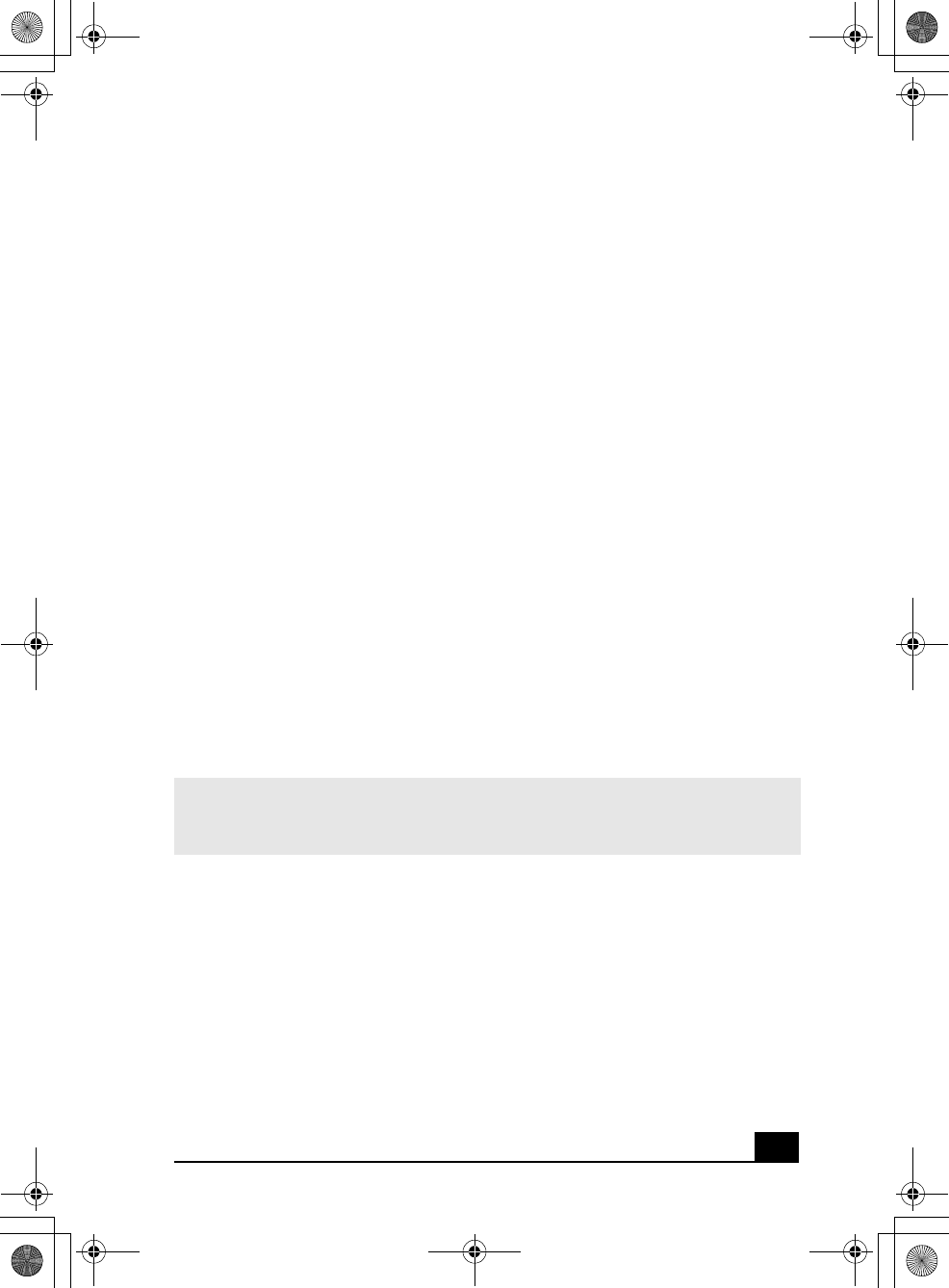
35
Troubleshooting
What do I do if my computer won’t start?
❑If your computer comes with a floppy disk drive, make sure the drive is
empty.
❑If you are using an external display, make sure the display is plugged into a
power source and turned on. Make sure the brightness and contrast controls
are adjusted correctly. See the guide that came with your display for details.
❑If the computer is plugged into a power strip or uninterruptible power supply
(UPS), make sure the power strip or UPS is turned on and working.
❑Make sure the computer is securely plugged into a power source or, if you
are using battery power, make sure the battery is inserted properly and
charged. You will know the power is on by the blinking power indicator. If
the computer is properly connected to a power source and still does not
work, follow these steps:
1Disconnect the AC adapter and remove the battery.
2Wait one minute.
3Reattach the AC adapter and reinsert the battery.
4Turn on the power.
❑Condensation may have accumulated on the computer causing it to
malfunction. If this is the case, wait at least one hour to use the computer.
✍If your computer has a reset button, you can use a thin, straight object (such as a
paper clip) to press this button to reset the computer. See “Locating Controls and
Ports” on page 17 for a description of the buttons on your computer.
Fuji3.book Page 35 Monday, December 15, 2003 6:34 PM

VAIO® Computer Quick Start
36
What do I do if the message, “Press <F1> to resume, <F2> to
setup” appears at the bottom of the screen?
1Press the F2 key to launch the BIOS Setup window.
2Set the date (month/day/year). Press Enter.
3Use the Down Arrow key to select System Time, set the time (hour:
minute: second), and press Enter.
4Use the Right Arrow key to select the Exit tab, and press the Down
Arrow key to select Get Default Values. The message Load default
values for all SETUP items appears.
5Press Enter. When the Setup Confirmation window appears, select Ye s ,
and press Enter.
6Select Exit (Save Changes), and press Enter. When the Setup
Confirmation window appears again, select Ye s , and press Enter. The
computer restarts.
What do I do if the Windows operating system does not start?
❑For models with a floppy disk drive, make sure the computer does not have a
non-bootable floppy disk in the drive. If a non-bootable floppy disk is in the
drive, remove the floppy disk and restart the computer.
❑You may need to initialize the BIOS.
1Turn off the computer.
2Remove any peripheral devices connected to the computer, and restart
the computer.
3Press the F2 key when the Sony logo appears to launch the BIOS Setup
window.
4Use the Right Arrow key to select the Exit menu, and then use the
Down Arrow key to select Get Default Values. The message Load
default values for all SETUP items appears.
5Press Enter. When the Setup Confirmation window appears, select
Yes , and press Enter.
✍If you receive this message on a regular basis, contact Sony Online Support
(http://www.sony.com/pcsupport).
Fuji3.book Page 36 Monday, December 15, 2003 6:34 PM

Troubleshooting
37
6Select Exit (Save Changes), and press Enter. When the Setup
Confirmation window appears again, select Yes , and press Enter. The
computer restarts.
My computer stopped responding. How do I turn it off?
❑Click Start on the Windows® taskbar, and select Turn Off Computer.
Select Turn Off Computer and click OK.
❑Press the Ctrl+Alt+Delete keys simultaneously. When the Windows Task
Manager dialog box appears, select the Shut Down menu and click Turn
Off.*
If these options do not work, press and hold the power button or slide and hold
the power switch until the computer turns off. You can also remove the power
supply as a final alternative.
* Recommended if the computer stops responding while playing a CD or DVD.
✍Pressing the Ctrl+Alt+Delete keys simultaneously or turning off the computer with the
power button or switch may cause loss of data.
Fuji3.book Page 37 Monday, December 15, 2003 6:34 PM

VAIO® Computer Quick Start
38
Support Options
If you have questions about your computer or the preinstalled programs, refer to
the following sources for answers in the sequence listed below.
1 VAIO® Computer Documentation
The on-screen VAIO® Computer User Guide and the printed VAIO®
Computer Quick Start provide information on how to maximize your
computer capabilities and solve common problems.
2 Program Guides and Help Files
The preinstalled programs on your computer may come with individual
help guides. These guides are stored on the hard disk as on-screen Help
files. You can find the Help files from the Help menu under the specific
program. To see a list of the preinstalled programs, click Start on the
Windows® taskbar, and select All Programs.
3 Operating System Online Support
Your computer comes preinstalled with a Microsoft® Windows®
operating system. For operating system support, you can visit Microsoft®
customer support at: http://support.microsoft.com/directory/.
4 Sony Online Support
This service provides instant access to information on commonly
encountered problems. Type a description of the problem and the
Knowledge Database searches for the corresponding solutions online.
You can visit Sony Online Support at: http://www.sony.com/pcsupport.
5 VAIO Update
When your computer is connected to the Internet, VAIO Update
automatically notifies you when critical software and security information
is posted on the support Web site. Click the VAIO Update notice to open
the VAIO Support Web site and view the information. You can also right-
click the VAIO Update icon in the Taskbar Notification area and
select Go to VAIO Web Support to open the support Web site.
Fuji3.book Page 38 Monday, December 15, 2003 6:34 PM

Fuji3.book Page 39 Monday, December 15, 2003 6:34 PM
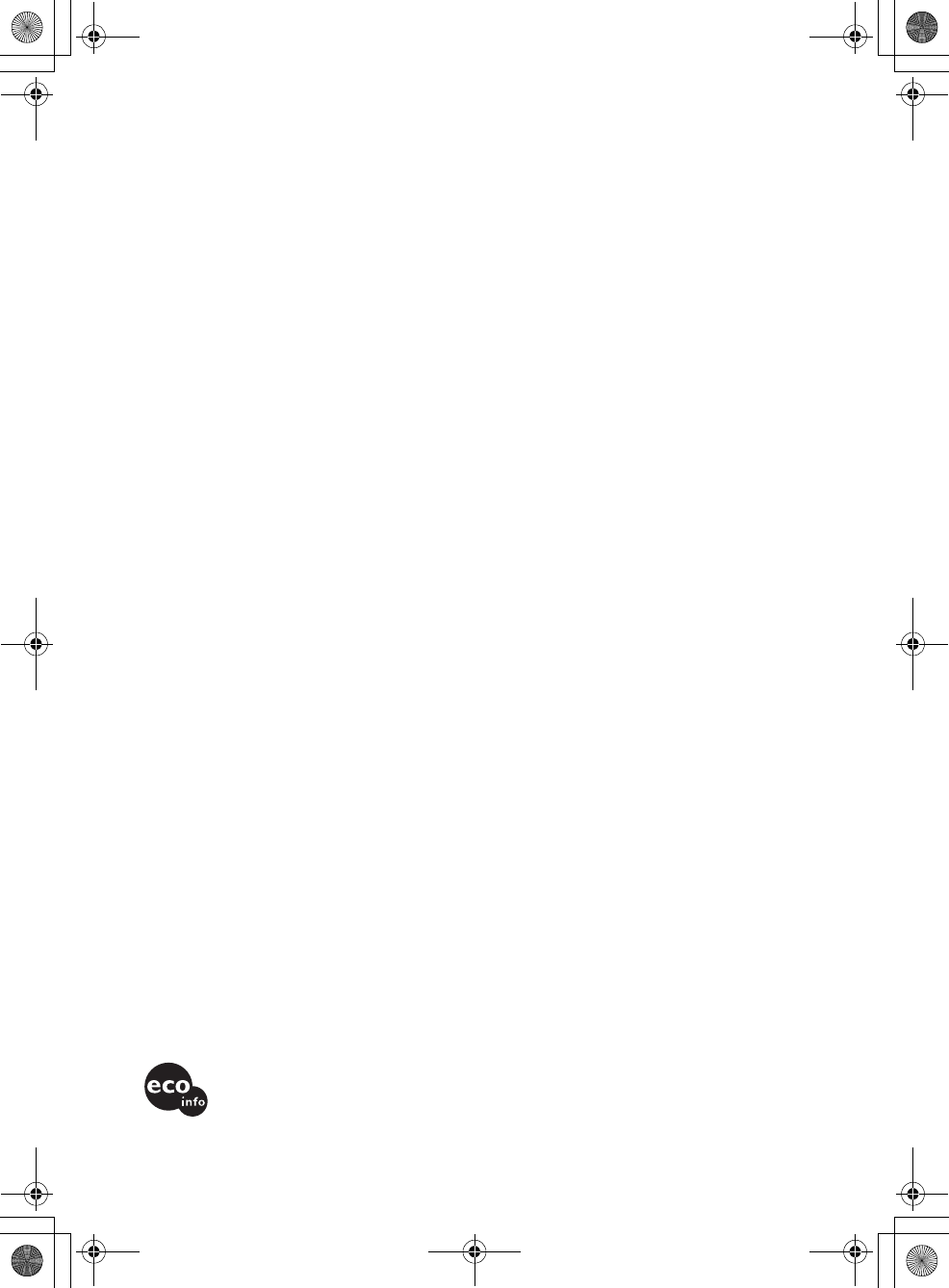
Printed in Japan © 2004 Sony Electronics Inc. 4-681-653-01
Printed on 100% recycled paper using
VOC (Volatile Organic Compound)
free vegetable oil based ink.
http://www.sony.com/vaio
Fuji3.book Page 42 Monday, December 15, 2003 6:34 PM